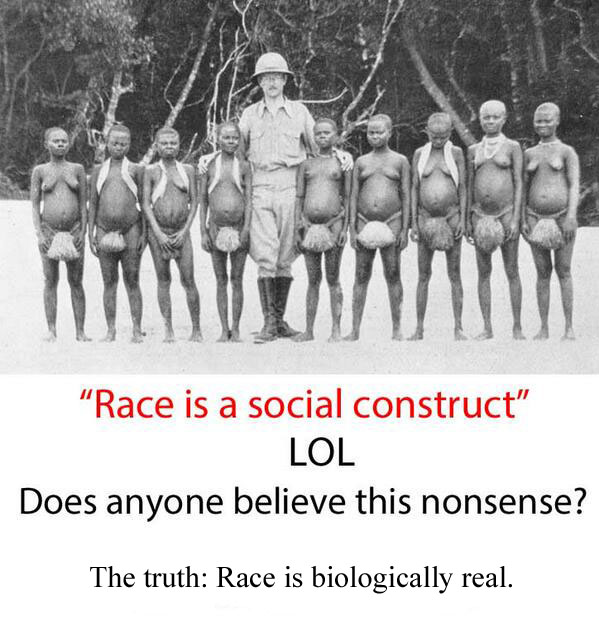
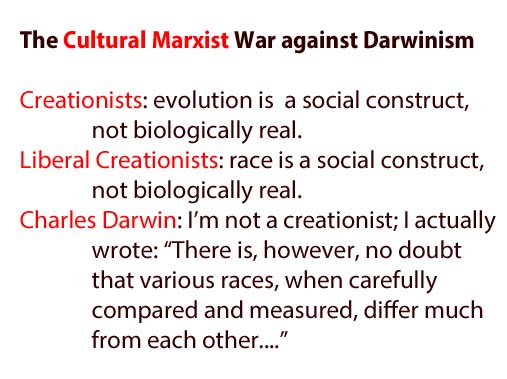



Lothrop Stoddard World Race Map (1920):
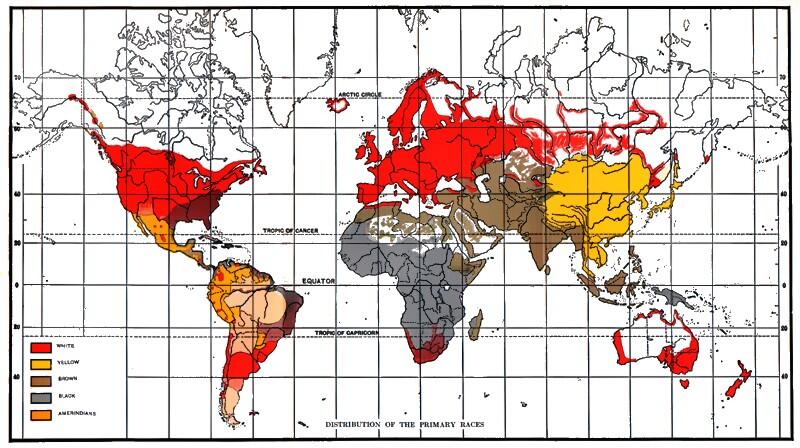
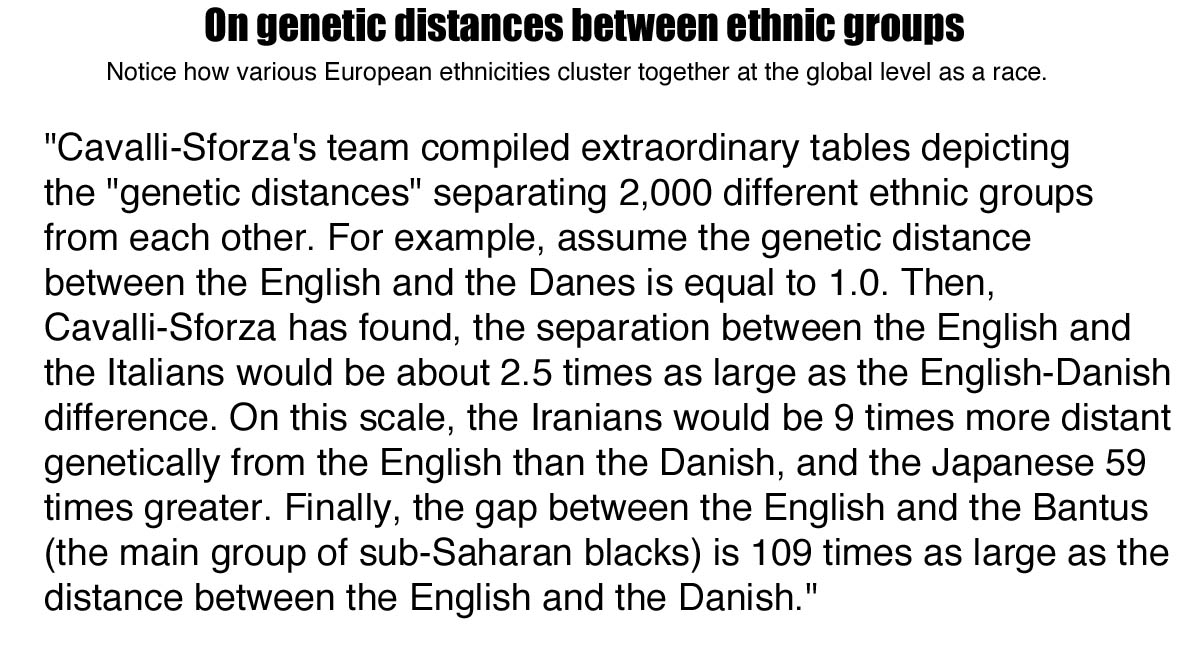
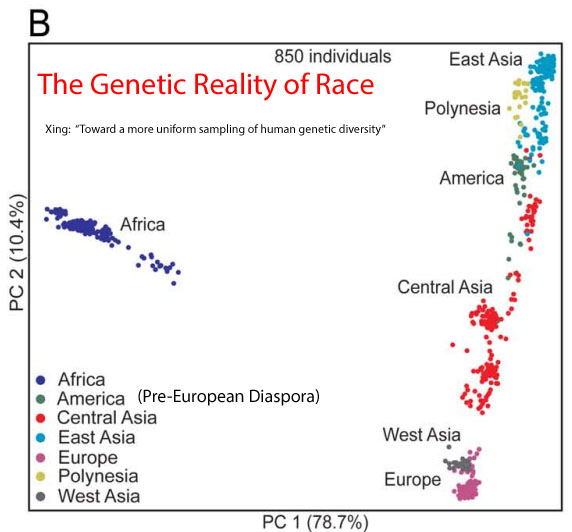
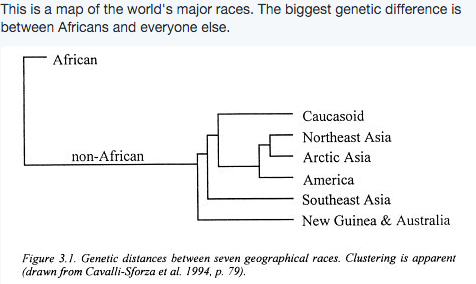
Faces of the World's Races
(Numbered plates from: Coon, Carleton S. Races of Europe. Greenwood Press, 1939. Or: Coon, Carleton S. The Origin of Races. Alfed A. Knopf, 1962.)
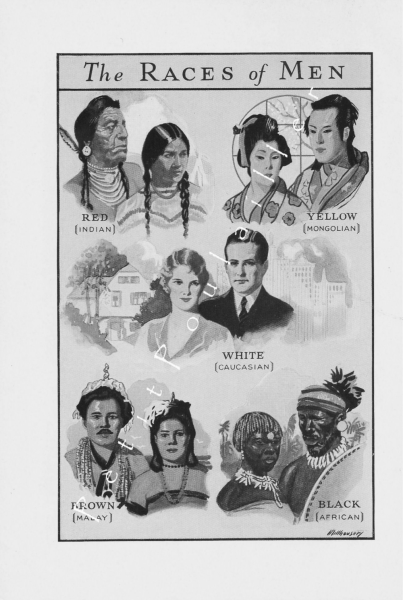
White People: Sub-Races or Ethnicities of Europe
Plate 27. The Nordic Race: Examples of Corded Predominance
The Nordic race is a partially depigmented branch of the greater Mediterranean racial stock. It is probably a composite race made up of two or more basic Mediterranean strains, depigmented separately or in conjunction by a progressive evolutionary process. As has been demonstrated on plates 9 and 10, it is impossible, as some European anthropologists believe, to derive a Nordic directly from a dolichocephalic Upper Palaeolithic ancestor of Brünn or Crô-Magnon type. Reduction of these overgrown races produces a result which is quite un-Nordic morphologically as well as in constitutional type. It is the author's thesis that the Nordic race in Europe was caused by a blending of the early Danubian Mediterranean strain with the later Corded element. At the present time both Corded and Danubian elements may be isolated, while other Nordics preserve the blended form. Nordics in eastern Europe, Asia, and North Africa may have been formed by separate recombinations or simple depigmentations of comparable Mediterranean strains, or by invasions of these regions from an European or West Asiatic depigmentation center.
FIG. 1 (3 views). A Finn of predominantly Corded type; note the ash-blond hair and grayish eyes, the great head length, and extremely low cephalic index. In head and face proportions a resemblance is seen to the Corded-like Irano-Afghan sub-type, a resemblance which is enhanced if pigmentation differences are ignored Both metrically and morphologically this individual is seen to be fully Mediterranean; there is no evidence of Upper Palaeolithic admixture.
FIG. 2 (3 views). A Swede from Sonderhamn who represents the same type, and who is very similar in most dimensions. The population of most of Sweden is predominantly Nordic; typical Upper Palaeolithic survivors are numerous only along the southwestern coast.
FIG. 3 (3 views). A Nordic Dane of Jutish parentage who also shows Corded predominance. His face is of extreme length, a trait common among ancient Corded crania. This individual is the son of the classic Borreby man shown on Plate 5, Fig. 1; this is graphic evidence of the fact that ancient racial types may be repeated in toto in individuals of mixed racial ancestry. Only through the agency of such segregation is it possible to present this collection of basic European racial photographs.
FIG. 4 (3 views). New Englander of Colonial British descent. This tall, slenderly built, ash-blond-haired Nordic is an extreme example of the Corded type which entered Britain first during the Bronze Age in conjunction with brachycephals, and later during the Iron Age as an element in the Nordic invading groups. Its presence in New England in 1938 can only be regarded as a complete reëmergence.
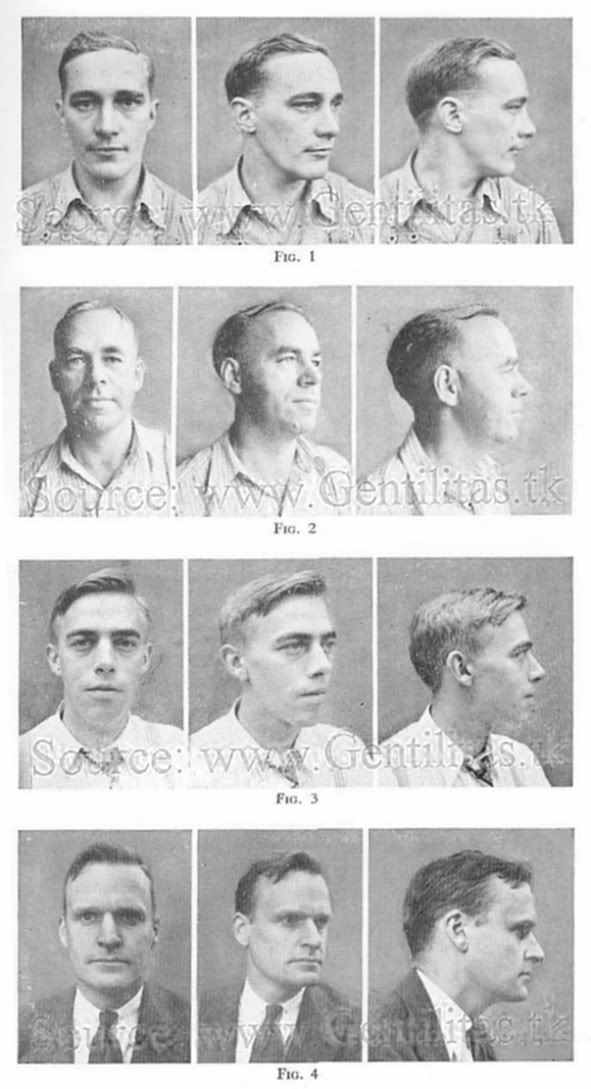
Plate 28. The Nordic Race: Examples of Danubian Predominance
In contrast to the last plate, the present one shows a series of Nordics in whom the Corded element is notably weak or absent, so that an approximation to the earlier, smaller-headed, mesocephalic Danubian strain is perhaps attained. The reason for qualification on this score is that not enough Danubian crania have been found and described to make this point certain.
FIG. 1 (3 views). A Norwegian from Drommen, near Oslo. The head is absolutely of moderate size, comparable to that of small brunet Mediterranean sub-varieties; the stature and bodily bulk are also small.
FIG. 2 (3 views). A mesocephalic Englishman from Southampton, whose small face, concave-profiled, round-tipped nasal form, and whose lack of angularity or bony extravagance in the cranial and facial skeleton, combined with a high vault, indicate a close similarity to the known skeletal remains of Neolithic Danubians.
FIG. 3 (3 views). A Galician of mixed Ukrainian and Polish parentage; an excellent example of the Danubian type, bound to the soil since the Neolithic, which has reemerged throughout the entire length of the rich agricultural plain which stretches across southern Poland and Russia, while Nordics proper have for the most part moved elsewhere.
FIG. 4 (3 views). A Lithuanian, who although brachycephalic, belongs essentially to the same Danubian type.
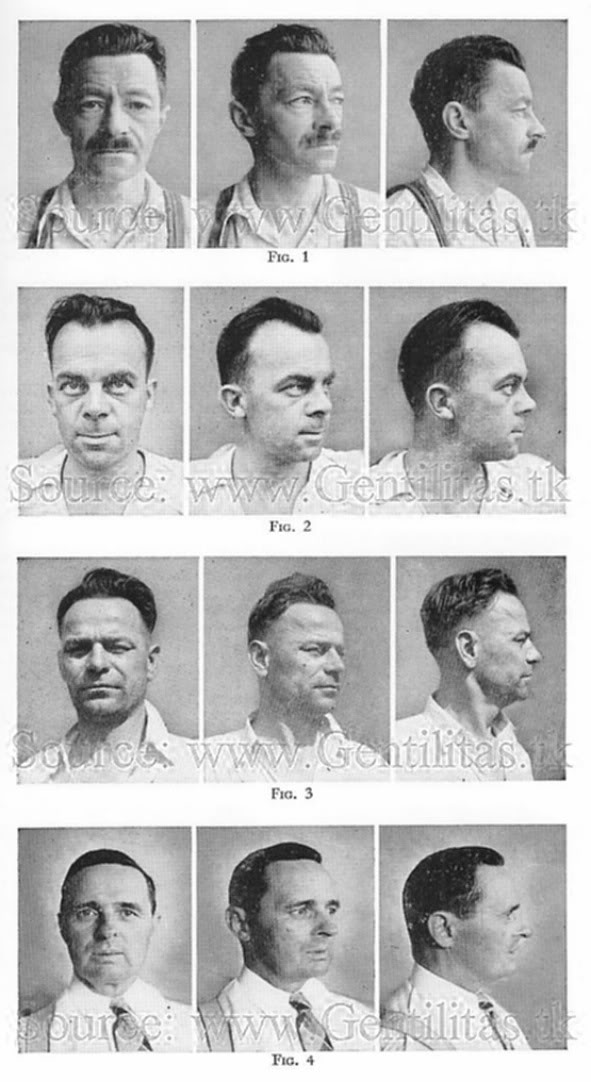
Plate 29. The Nordic Race: Hallstatt and Keltic Iron Age
Types Description missing.
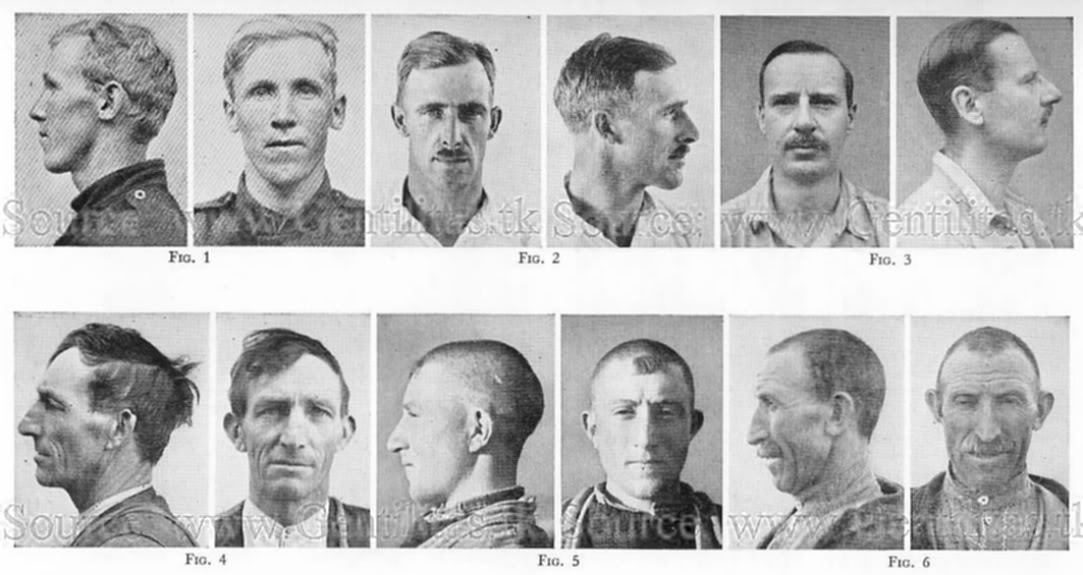
Plate 30. Exotic Nordics
Description missing.
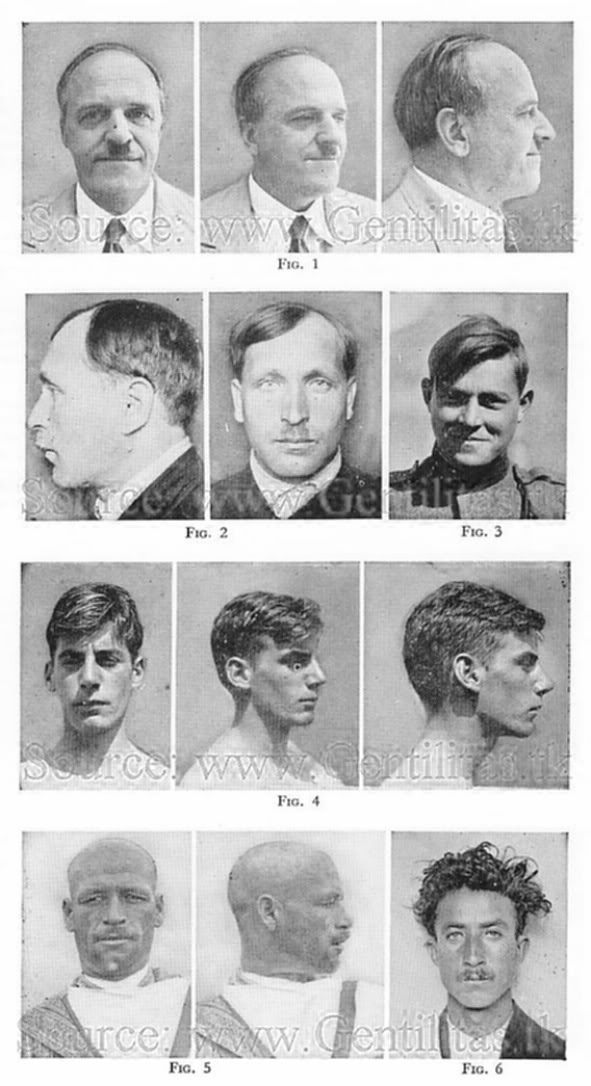
Plate 32. Nordics Altered by Northwestern European Upper Palaeolithic Mixture: I
Description missing.
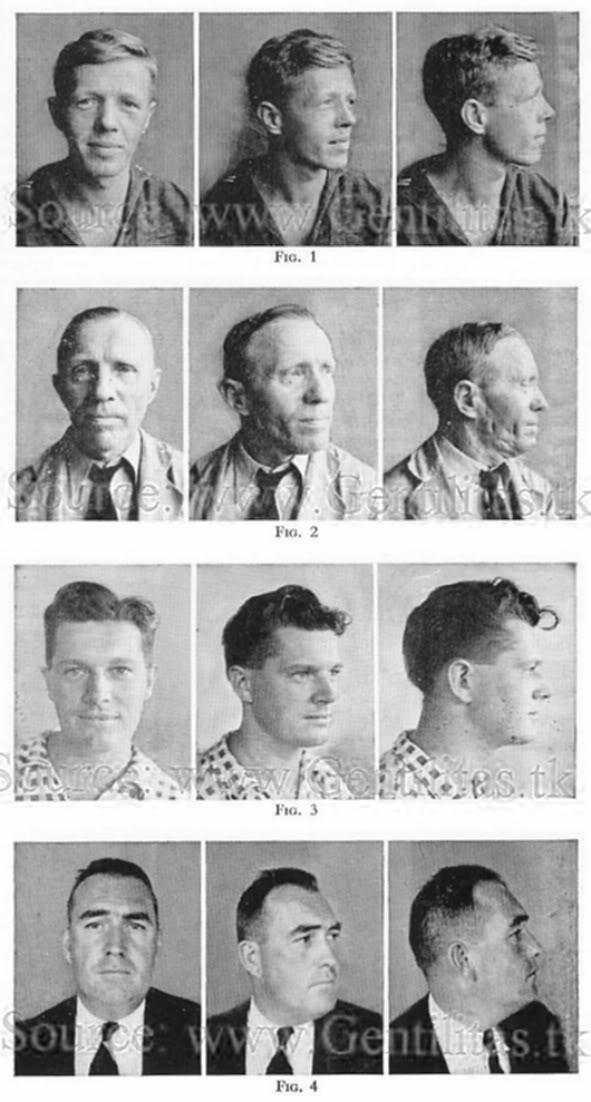
Plate 33. Nordics Altered by Northwestern European Upper Palaeolithic Mixture: II
Description missing.
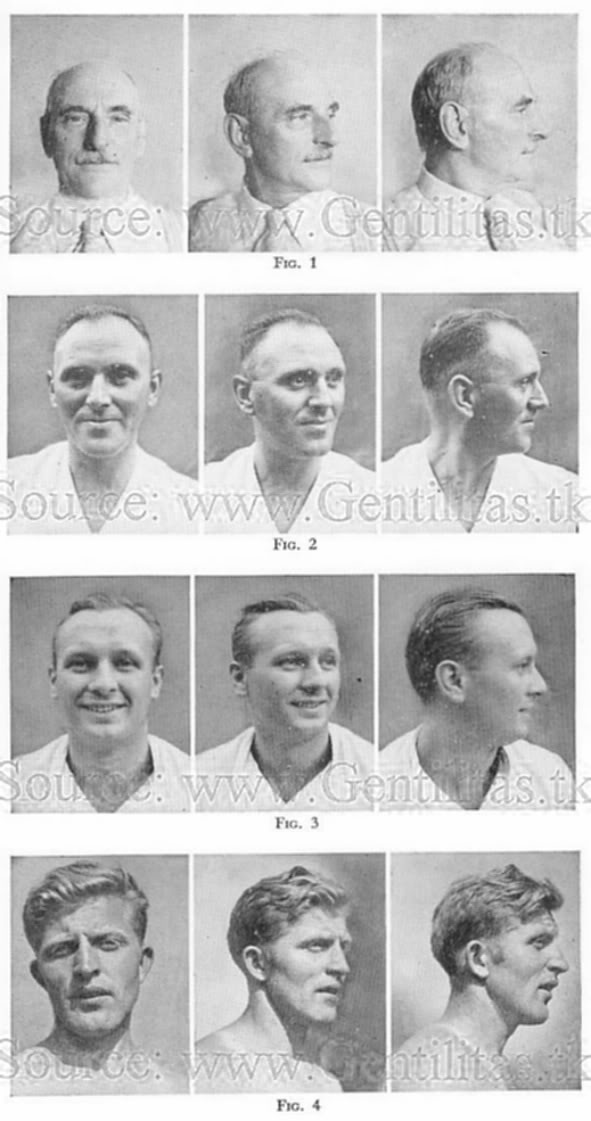
Plate 34. Nordics Altered by Mixture with South-Western Borréby and Alpine Elements
Description missing.
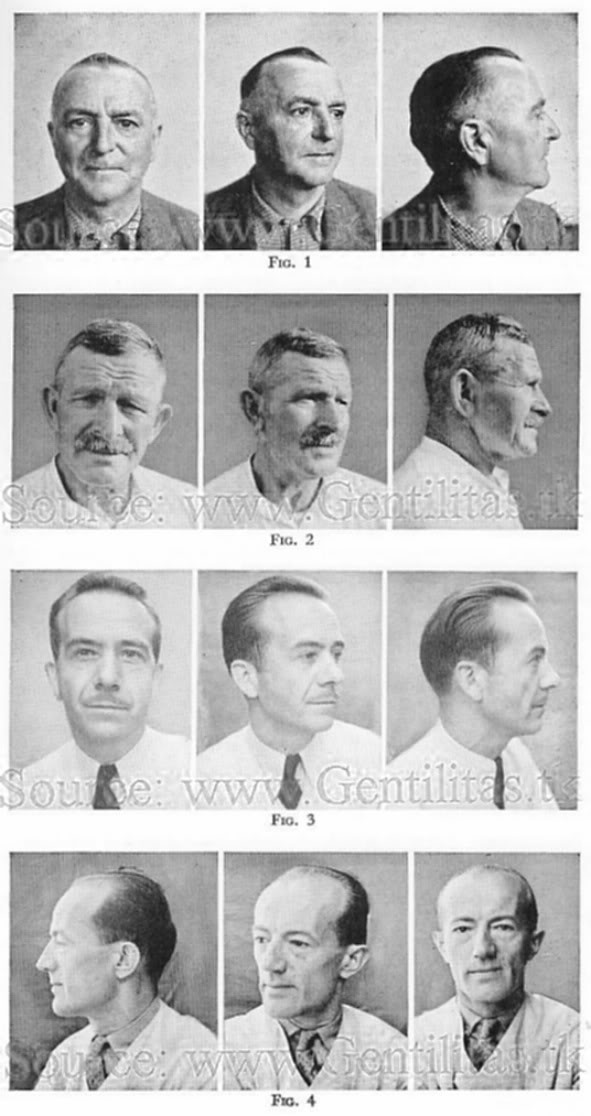
Swedish Nordic Types (From The Swedish Nation and Racial Types by Herman Lundborg)
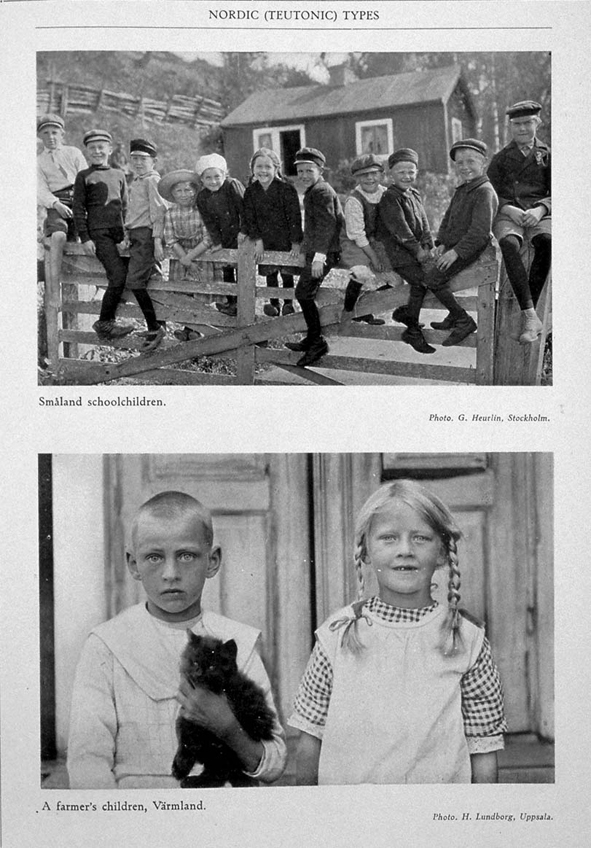
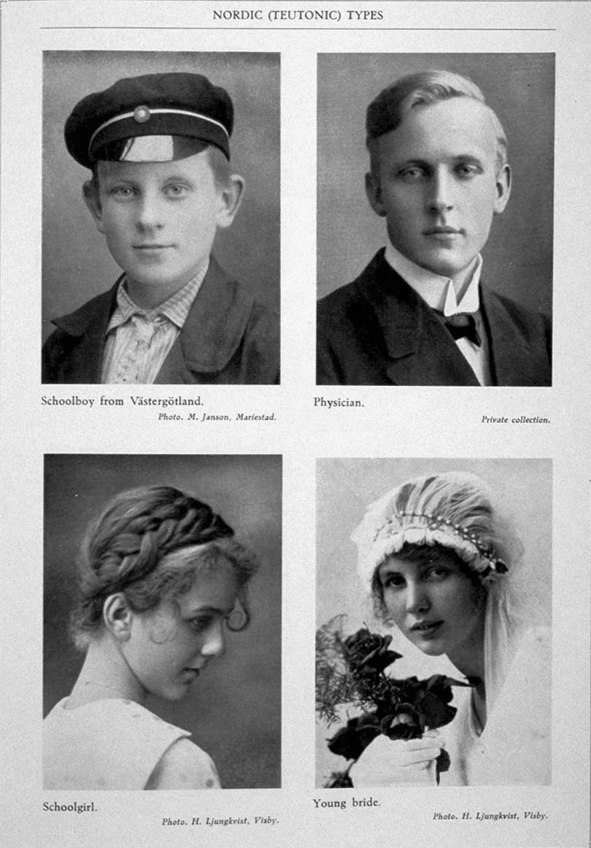
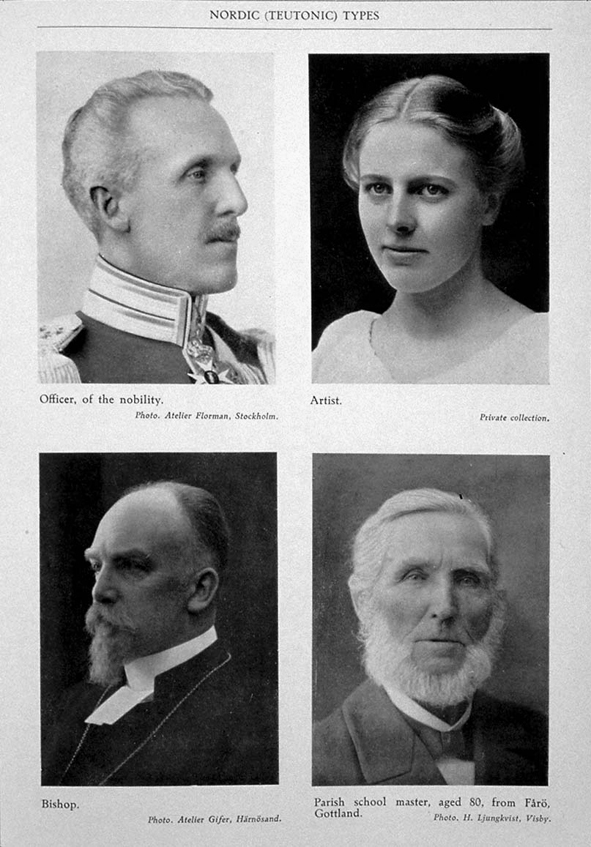
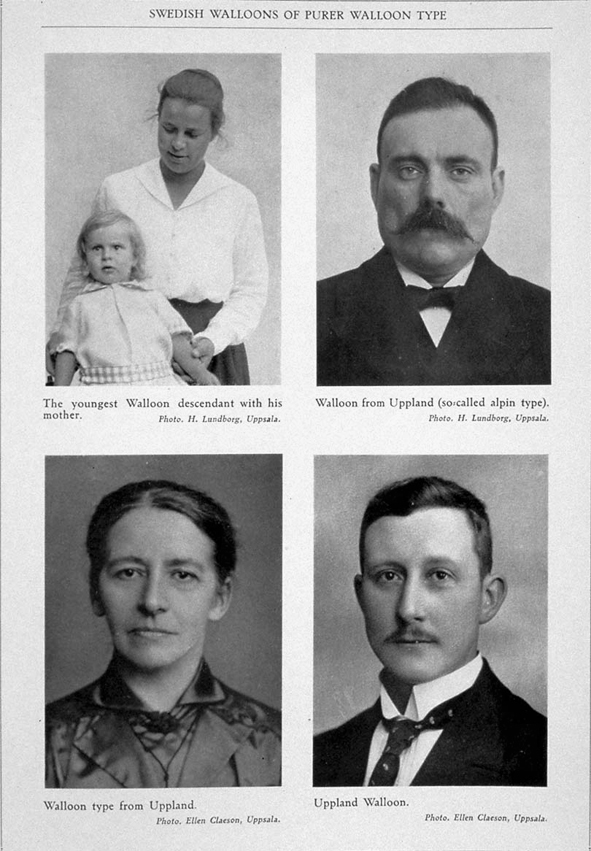
Plate 35. The Principle of Dinaricization
Description missing.
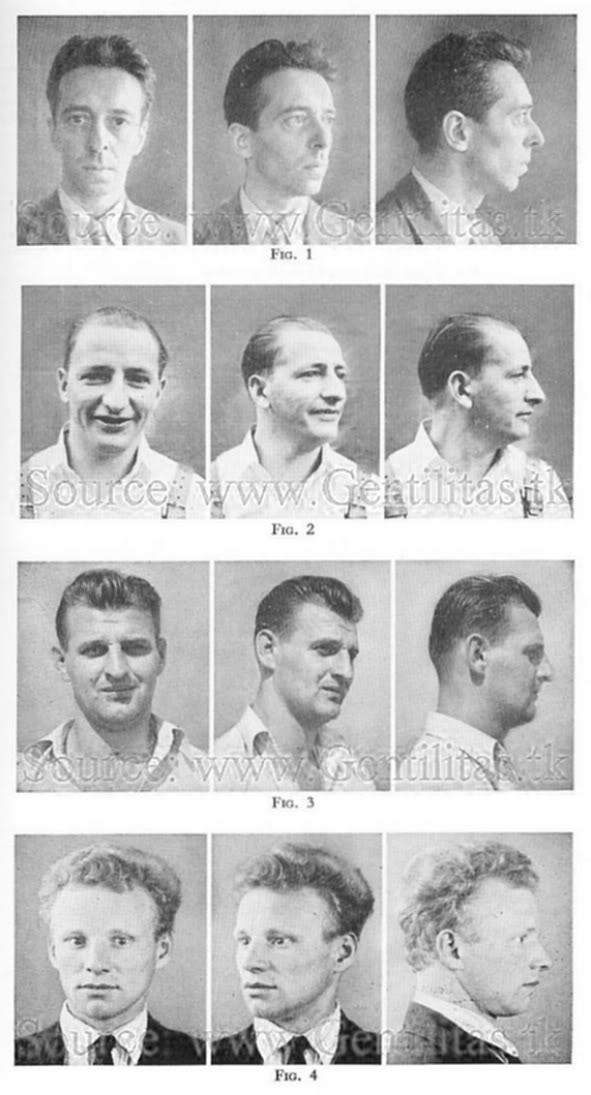
Plate 31. Neo-Danubians
Description missing.
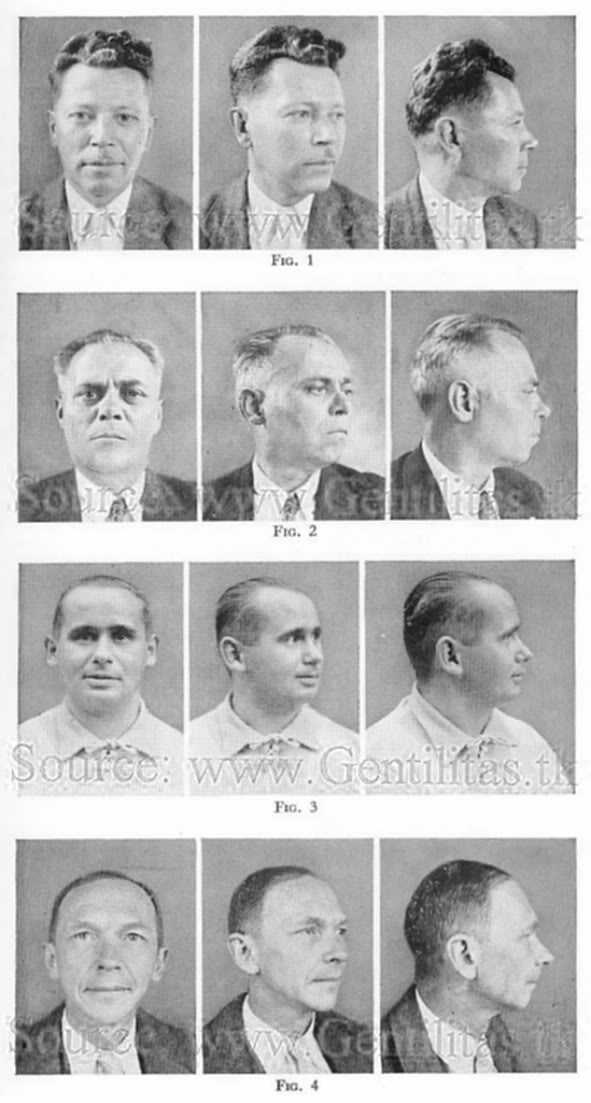
Plate 4. BRÜNN SURVIVORS IN SCANDINAVIA
All Upper palaeolithic survivors may be divided into two general groups (a) those who have been subjected to reduction in head size and bodily bulk, and who, have been partially foetalized in the course of the same process; and (b) those who retain the head size, bodily bulk, and masculinity of features characterstic of the Pleistocene hunters. Most of the latter group are to be found in northwestern Europe. Dolichocephalic individuals who recapitulate the metrical and morphological qualities of the Cro-Magnon and Brunn-Predmost Aurignacian people are commonest in Scandinavia and in Ireland. In Scandinavia they are found concentrated along the southern Swedish coast in the neighborhood of Goteborg, and in the mountains of southwestern Norway.
FIG. 1 (3 views). A Swede from Trollhatton, southern Sweden. This man is both tall and heavy; of lateral bodily build. His head is of prodigious length, his face nearly as wide as his cranial vault; all dimensions of the face are great, especially the width of the mandible; the distance between the eyes, and the heaviness of the browridges, are likewise remarkable. This individual recapitulates, as closely probably as any other living human being, the physical type of many of the hunters who lived in western and central Europe during the Laufen Interglacial and the last advance of the ice. Note that in his case, as with most of his type, only a partial degree of blondism is present.
FIG. 2 (3 views). Another Swede, in this case from Goteborg, a slightly less extreme example of the same type. Swedes of this type are habitually found in association with the sea. Both of these individuals, as well as Fig. 4, were measured and photo- graphed in a Boston shipyard.
FIG. 3 (3 views, from Alette Schreiner, Anthropologische Lokaluntersuchungen in Norge; Valle, Halandsdal, und Eidfjord. Oslo, 1930. #113). This Norwegian from the isolated mountain settlement of Valle in southwestern Norway represents the same basic type as the two men above; his face and mandible, however; are narrower; and his hair ash blond; admixture with Nordics is indicated.
FIG. 4 (3 views). The same conclusion is suggested in reference to this extremely long- faced and golden-haired Swede from Helsingborg. He is, however, much larger in head and face size, much heavier in body build, and heavier in the facial skeleton than any Nordic. The predominant strain is Upper Palaeolithic.
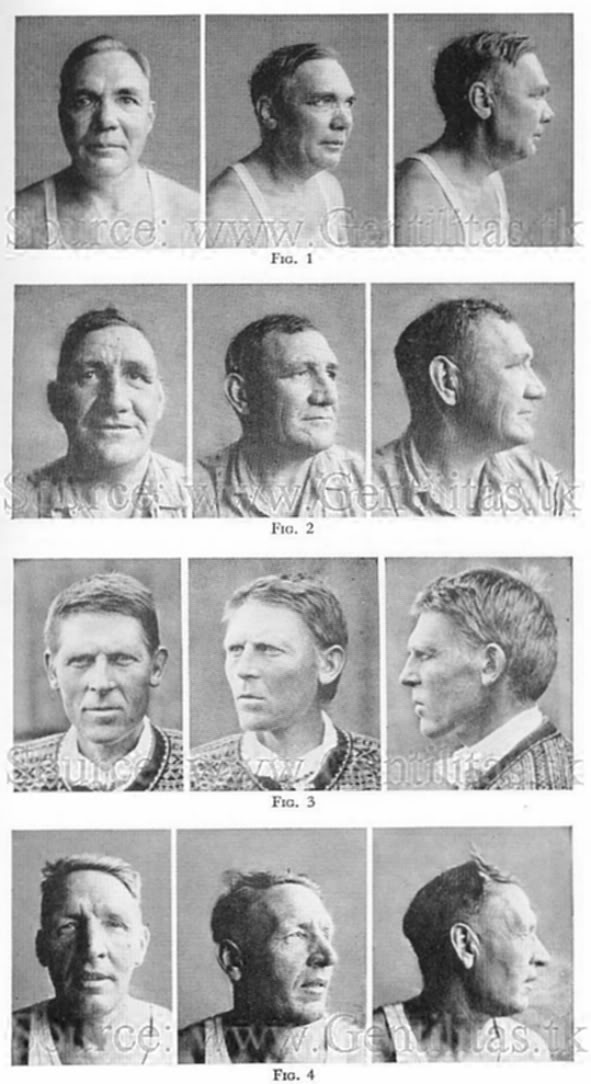
Plate 5. BORREBY SURVIVORS IN THE NORTH
In the same districts of southern Sweden where Brunn survivors are found, and across the Skaggerrak in Jutland, are found brachycephalic Upper Palaeolithic survivors, equally unreduced in head and body size, equally if not more lateral in bodily build. The ancestors of, these people arrived on the western Baltic shores during the Late Mesolithic. Other colonies of them are to be found in the coastal districts of south- western Norway, and they form an element of primary importance in the population of Germany. In general, their present distribution is wider than that of their dolicho- cephalic counterparts.
FIG. 1 (3 views). A Dane from Jutland, very tall, heavy, lateral in build, with an enormous head and an extremely wide face. This individual is as exaggerated an ex- ample of the Borreby race as is #1 of the preceding plate of the Brunn race.
FIG. 2 (3 views). A Swede from Goteborg, representing more nearly the mean of the Borreby race as it is found today. Both this man and #1 are golden blond in hair color; the Borreby group seems to run lighter-haired than the Brunn.
FIG.3 (2 views, Bryn and Schreiner; Die Somtitologie der Norweger, Table 44, Fig. 121). This individual, while less brachycephalic than many of his compatriots, especially those in the Jaeren district, shows an essential affiliation to the Borreby race. The apparent facial flatness and the formation of the region of the nasal tip and the upper lip look "Irish"; this is an Upper Palaeolithic facial condition common both to Scandinavians and to British of Upper Palaeolithic type.
FIG.4 (1 View, Gudmundur Kamban, author of I See a Wondrous Land, G. P. Putnam & Sons, N. V.). A prominent Icelandic author, who presents the same facial features and belongs to the general Borreby racial type. Iceland was settled mainly from the coastal regions of Norway in which the Borreby race is prevalent; an important Irish increment may have added a similar racial element.
FIG. 5 (3 views). A Finnish example of the Borreby race. This Finn is more brachycephalic than most Borreby men; however his lateral bodily build, and his extreme breadth of face and mandible show that he is a trans-Baltic member.
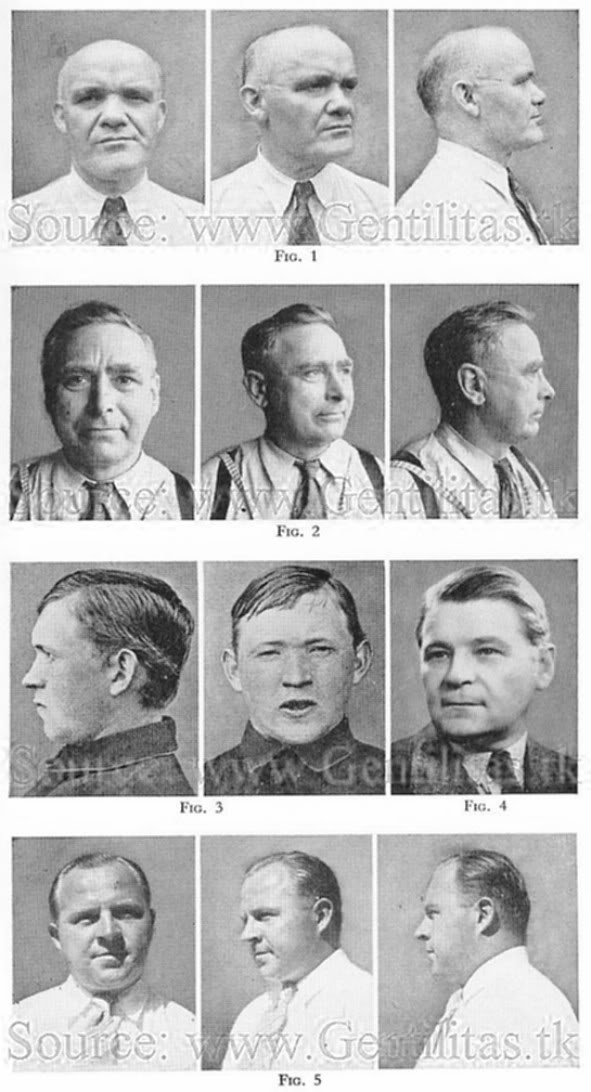
Plate 6. BORREBY MEN IN GERMANY AND ELSEWHERE
The Borreby race was a relatively late Mesolithic arrival in Scadinavia; its earlier seat was central Germany, with ramifications both to the east and the west. Today it is probably the one most important racial element in much of northern and central Ger- many, with wide ramifications elsewhere. Its German form is, however, seldom as exaggerated as that in the north. In this sense it is partly transitional to the Alpine race on the one hand, and to the Ladogan on the other.
FIG. 1 (2 views, Sailer, K., "Die Fehmaraner ," Deutsche Rassenkunde, vol. 4,1930, Tafel 41, #H-l1, #2193). A concentration of a specialized and exaggerated Borreby type or types is found on the island of Fehmaran, between the Danish Archipelago and Germany. The individual shown has especially heavy browridges and a great nasion depression. Others are often rounder-faced and usually show less exaggerated facial profiles. The browridges on this individual recall Upper Palaeolithic prototypes.
FIG.2 (1 view, C. W. Dupertuis, Century of Progress). A German Borreby type with the excessive head breadth of 175 mm., which must be one of the widest non-deformed head breadths ever measured. This width is greater than the lengths of some heads shown in this section.
FIG. 3 (3 views). A characteristic West-German Borreby type, from Stuttgart. The southwest-German Borreby nucleus has mixed with all invaders from the initial Neolithic onwards. It was with Borreby people from this region that the Bell-Beaker Folk mixed, before their invasion of Britain in the Early Bronze Age.
FIG. 4 (3 views). A metrically typical Borreby specimen, a White Russian from the region of Vilna. The presence of this type to the southeast of the Baltic establishes its continuity between Germany and Finland.
FIG. 5 (3 views). A North Italian from Lombardy, who, although brunet in hair color, conforms metrically and morphologically to the Borreby standard. He comes from typically Alpine and Dinaric territory.
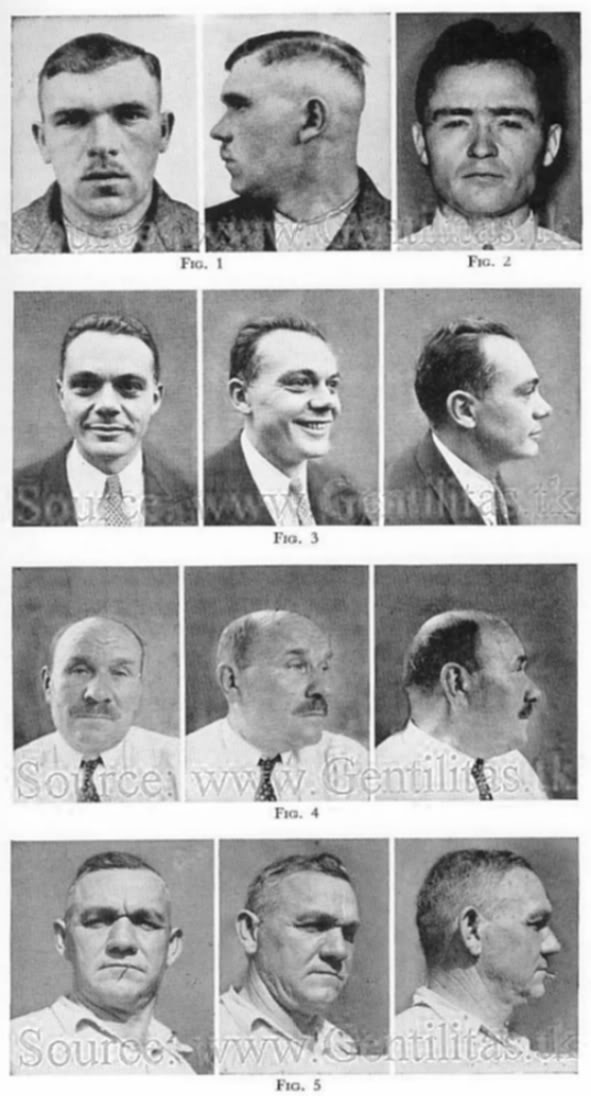
Plate 11. THE ALPINE RACE IN GERMANY
The Alpine race is a reduced Upper Palaeolithic survivor; Alpines are as a rule of but medium stature, and lateral in bodily build; their heads of moderate size and globu- lar; their faces characteristically round and their facial features slightly infantile. Their pigmentation ranges from blond to brunet, but is usually intermediate. The Alpines represent a reemergence of a brachycephalized and partially foetalized Palaeolithic sur- vival in the central highland and forest zone of Europe and Asia, all the way from the Pyrenees to the Pamirs. Alpines are at the root of all or nearly all the brachycephalic racial types throughout this entire expanse of territory. The Alpine territorial distribu- tion is not the result of an invasion or expansion, but of a parallel set of emergences. In Europe, southern Germany is the seat of one of the greatest Alpine concentrations in the continent. The best place in the world to find Alpines is in a Bavarian restaurant; that is where all four individuals on this plate were photographed and measured.
FIG. 1 (3 views). A metrically and morphologically perfect Alpine, from Branden- burg.
FIG. 2 (3 views). A tall, curly-haired, and portly Alpine from the Hirschenberg, near Miesbach, Upper Bavaria; this individual might be considered the quintessence of a Bavarian.
FIG. 3 (3 views). An Alpine from the Black Forest, Baden.
FIG. 4 (3 views). An Alpine from the Spreewald, of German, not Wendish, origin. The low brachycephalic index, and the relative fineness of the facial features indicate a tendency in a Nordic direction.
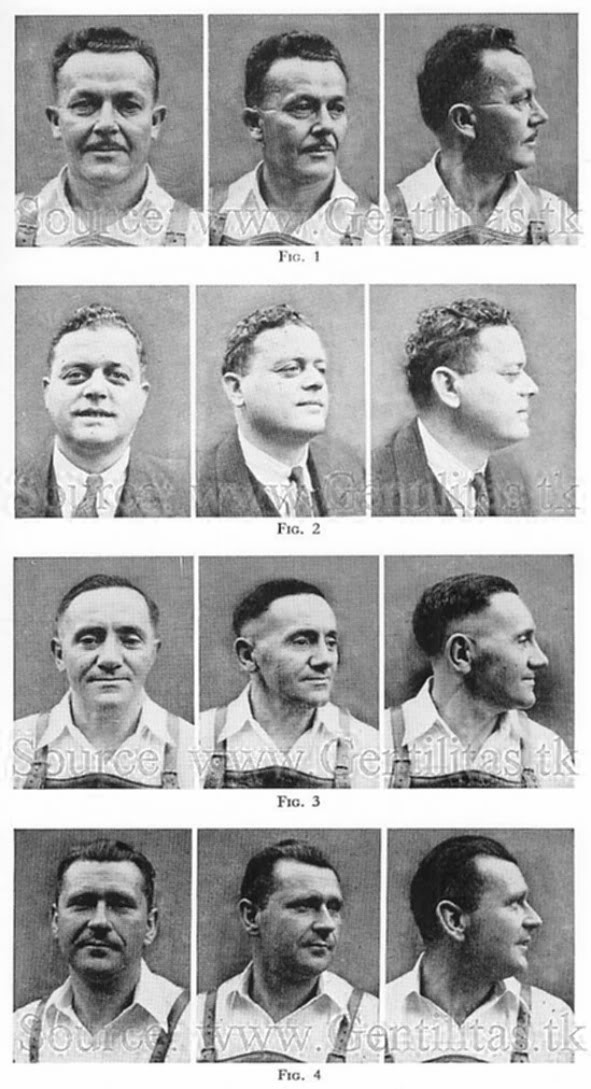
Germanic Americans
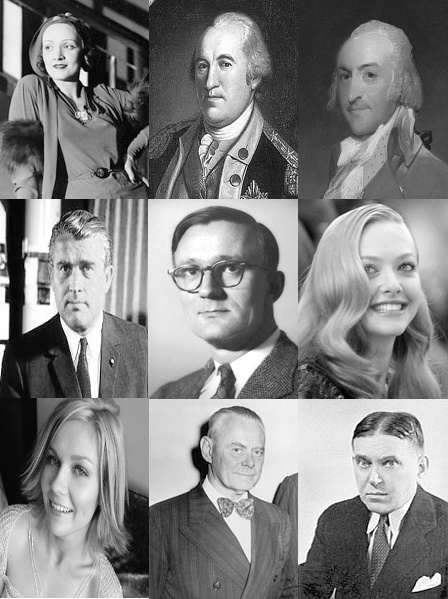
Scots-Irish / Scotch-Irish Americans
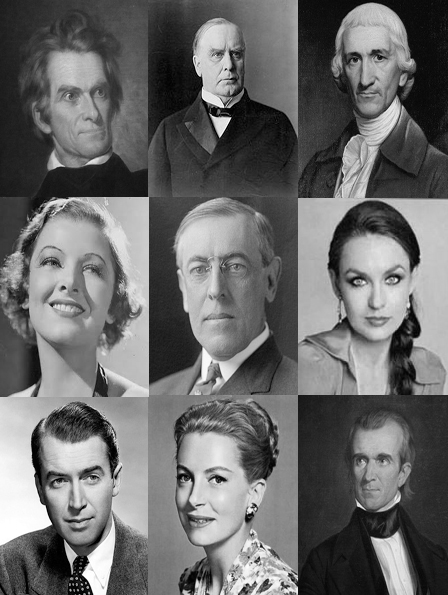
Plate 12. THE ALPINE RACE IN WESTERN AND CENTRAL EUROPE
FIG. 1 (3 views). A Basque from Vizcaya, Spain. This blond Basque was rufous and freckled in childhood; his curly hair and facial features give him an Irish appearance. Nevertheless his general racial classification is with the Alpine group. This is an un- common type for a Basque, since most of them are Atlanto-Mediterraneans and Dinarics.
FIG. 2 (3 views). A perfect example of a French Alpine. This individual is a Parisian, but his mother came from the Pyrenees.
FIG. 3 (3 views). A Ladin-speaking Swiss from the Canton of Ticino (Tessin). A fully brunet Alpine, typical of southeastern Switzerland and northem Italy.
FIG. 4 (3.views). A Czech from Bohemia, Alpine morphologically but not as brachycephalic as the Alpine mean.
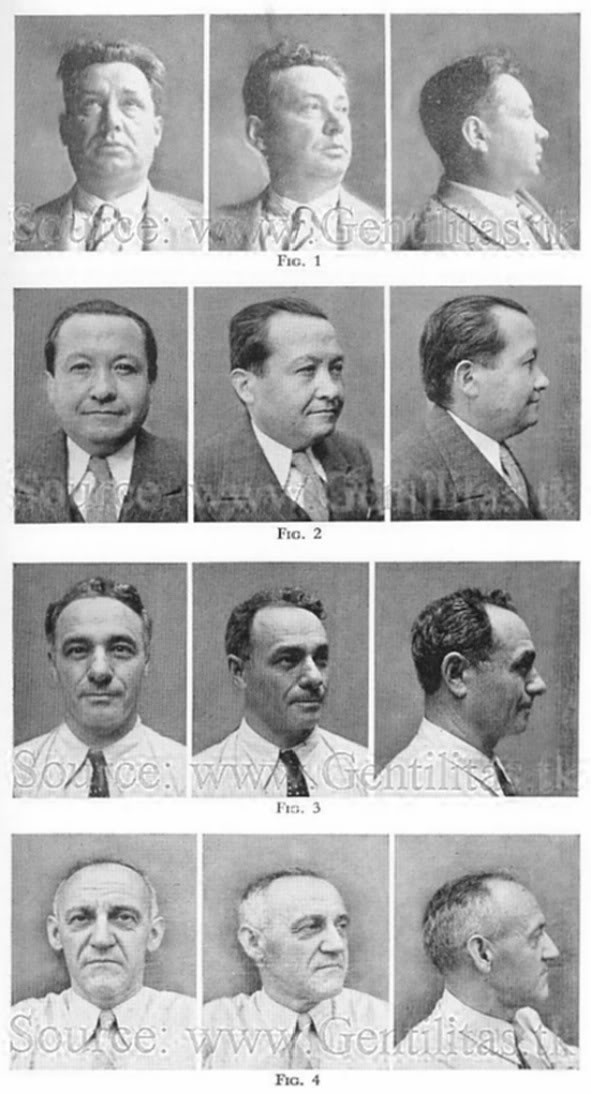
Plate 13. ABERRANT ALPINE FORMS IN WESTERN AND CENTRAL EUROPE
FIG. 1 (3 views). A Scotsman from Aberdeen, with blue eyes and dark brown hair. This brachycephalic Aberdonian is Alpine in head form and in most facial features; the length of the face and of the nose, however, are aberrant and point to non-Alpine in- fluences. The predominant Alpine element present in this individual is presumably that which entered Scotland from the Continent during the Bronze Age with the Short Cist People. Other brachycephalic Scotsmen sometimes show Borreby features.
FIG. 2 (3 views). A Frenchman from the Limousin region; father from the Dordogne, mother from Limoges. The sloping forehead and prominent nasal profile of this indi- vidual, as well as his long face and wide jaw, indicate non-Alpine influences; he pre- sumably carries a strain of the large-headed early Mediterranean or Upper Palaeolithic element prevalent in this part of France and first noticed by Ripley.
FIG.3 (3 views). A Frenchman from Doubs, in Burgundy. This large-headed and relatively tall northeastern Frenchman represents the local brachycephalic type differentiated from the south central French Alpines largely by stature and pigmentation
FIG. 4 (3 views). A Walloon, born in France, whose parents were from Ghent. Large-headed, not excessively brachycephalic, this individual is typical of the Wal- loon-speaking population of the hilly southeastern half of Belgium.
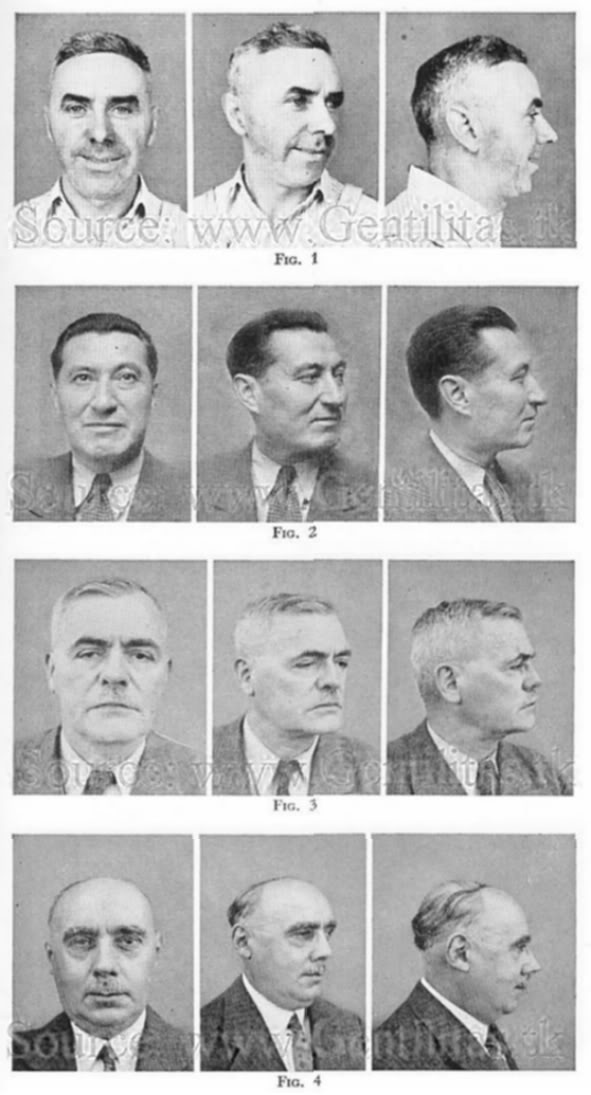
Plate 14. ALPINES FROM CENTRAL, EASTERN, AND SOUTHEASTERN EUROPE.
East of Bavaria, Bohemia, and Switzerland, typical Alpines are relatively rare until. one reaches southern Albania and Greece; their northeastern limit of frequency is the Carpathians, and between the Carpathians and the Adriatic, they are usually found in a hybridized (Dinaricized) form.
FIG. 1 (3 views). Magyar from Pecas, Hungary. This tall Alpine from Hungary is except for his stature, as perfect an example of the Alpine race as could be found; he may be compared to the Alpines on Plate 11, from Germany. Hungary is ethnically a composite nation, and this individual's family has traditions of both French and Ger- man admixture.
FIG. 2 (3 views). Ukranian from Novograd Bolynsk, in the Volhyn District. Like many Volhynians, this individual is predominantly Alpine, although he shows evidence of Atlanto-Mediterranean or Nordic admixture, or both. The Volhyn constitutes in part an Alpine sub-nucleus to the northeast of the Carpathians.
FIG. 3 (2 views, photo Marion Lambert). A Tosc from Katundi, southern Albania. This man is as perfect an Alpine as the Hungarian on the preceding plate, the French- man on Plate 12,
FIG. 2, or the Germans on Plate 11. Southern Albania forms an Al- pine nucleus comparable to that in south central France or Bavaria.
FIG.4 (1 view). Another Alpine Tosc; in this case from Gjinokaster, in the extreme southwest of Albania, bordering on Epirus.
FIG. 5 (3 views). A Greek from Sparta. The Alpine strain of southern Albania ex- tends down through western Greece into the. Peloponnesus. In Greece it is frequently blended with a local tall Mediterranean strain.
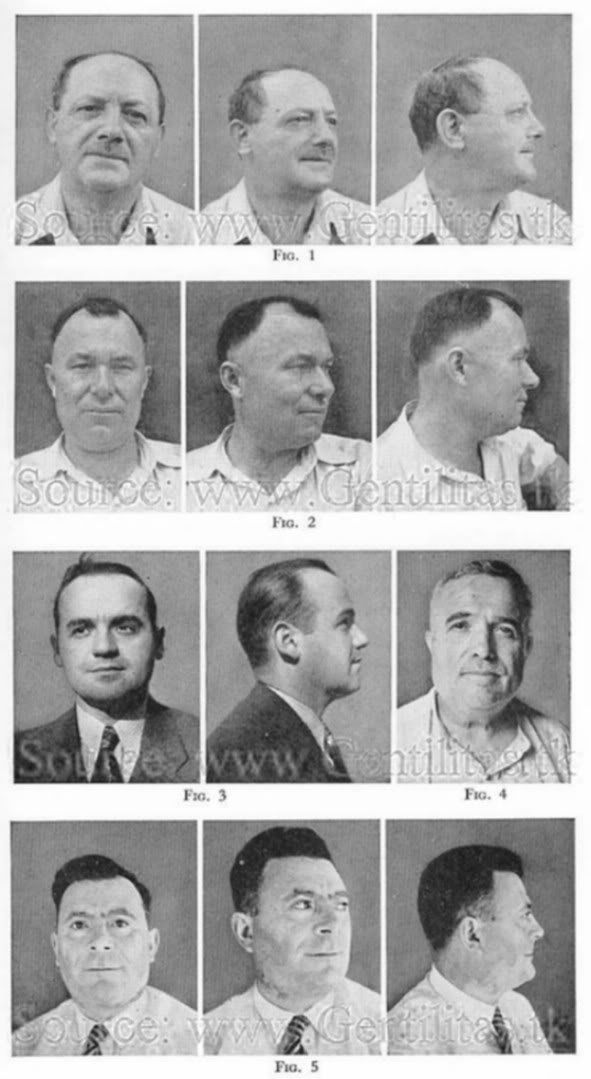
Plate 25. THE MEDITERRANEAN REEMERGENCE IN GREAT BRITAIN (Read: On racial homogeneity of the British Isles.)
The Atlanto-Mediterraneans were not the only members of the Mediterranean stock to invade Great Britain; smaller Mediterraneans are commonest in Wales and in the former Cymric territory which stretches from the Midlands to Glasgow. With the rise of the industrial revolution, the population increased greatly in these two last named regions, which became the most heavily industrialized areas in Britain; hence the Mediterranean increment in the British population has risen during the last century and a half.
FIG. 1 (3 views). A Lancastrian from Blackburn, a slender, delicaltely built Mediterranean with an extremely narrow nose and mandible. He represents a characteristic Midlands type.
FIG. 2 (3 views). A metrically similar New Englander from a Massachusetts coastal city, of Colonial Yankee lineage. He represents, a reemergence or survival within the New England stock of the same British Mediterranean element.
FIG. 3 (3 views). A Welshman from the neighborhood of Cardiff. An absolutely great head length, a heavier facial structure, and a less leptorrhine nose form indicate a different Mediterranean sub-type from the two above.
FIG. 4 (3 views). A Mediterranean Scotsman from Paisley; typical of the industrial population of the Glasgow district.
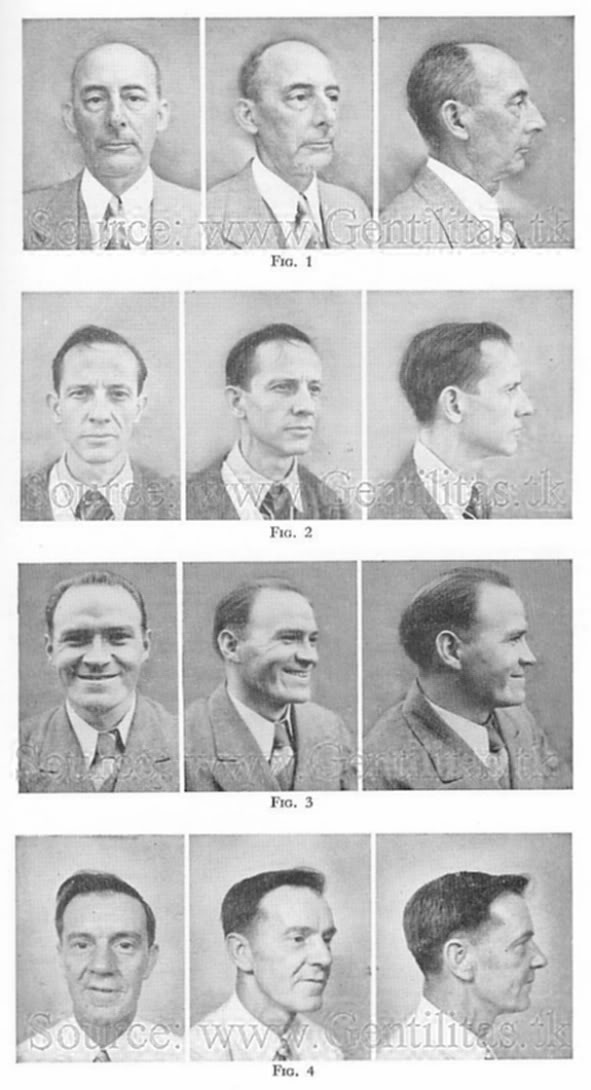
Plate 9. UPPER PALAEOLITHIC SURVIVALS IN IRELAND
Ireland was first settled in the post-glacial Mesolithic by people of Upper Palaeolithic type coming overland from Scotland. The Mesolithic cultural period was long and full in Ireland, and the subsequent invaders of this westernmost fringe of Europe have been unable to effect a genetic displacement of the strain introduced by the earliest human occupants. This strain has undergone an evolution of its own in Ireland, as the presence side by side of individuals showing various stages and types of change will make clear, .
FIG. 1 (3 views). County Cork. A man of medium stature but great body size, mas- sive bony structure and heavy musculature; a large head, heavy brows, deep, wide man- dible and projecting chin. This individual is a close Irish approximation to the Brunn race of Scandinavia. His golden hair is curly; curly hair is a local specialty of the Irish Upper Palaeolithic group. It is also, however, occasionally found among Lapps and Finns.
FIG.2 (2 views, photo C. W. Dupertuis). County Clare. Cork, Kerry, and Clare are the three Irish counties in which unreduced Palaeolithic survivors form the major ele- ment in the population. This large individual has ahead of full Brunn-Vorreby size di- mensions, but one that is intermediate between the two Scandinavian types in fom. This is typical of the Irish Palaeolithic group, which is characteristically mesocephalic. or sub-brachycephalic and forms a single unit in this respect. The individual depicted possesses a mandible of extreme width, comparable to the widest in Scandinavia. Note that the hair is red and the complexion florid; rufosity is closely linked to Upper Palaeo- lithic survival in Ireland.
FIG. 3 (1 view, photo C. W. Dupertuis). Another Clare man of similar type but less extreme dimensions. This type of Irishman is very common in America.
FIG. 4 (2 views, photo C. W. Dupertuis). An Irishman from Leitrim, whose facial features are typically Irish, and yet who approximates a Nordic form in most anthropo- metric dimensions. There may well have been Nordic mixture involved in the produc- tion of this type, taking the form of a simple reduction in lateral size dimensions. In any case the facial features are of pure Upper Palaeolithic inspiration.
FIG.5 (1 view). A Finn from Vasa (S. Ostrobothnia), who is anthropometrically and morphologically very close to the Irishman from Leitrim. The same curly hair, and the same conformation of the forehead, lips, and nose have produced a striking similar- ity. This and other evidence indicate that features which in Finns are often popularly supposed to be mongoloid are actually of European Upper Palaeolithic inspiration.
FIG.6 (2 views, photo C. W. Dupertuis). A small-headed, absolutely short-headed and snub-nosed youth from County Longford. This individual serves as an excellent example of the extreme in size reduction and in partial foetalization which has taken place in some Irish Upper Palaeolithic survivors, comparaple and parallel to the de- velopment of the Alpine race on the Continent.
FIG.7 (1 view). County Cork. An example of notable facial and alveolar progna- thism in the case of a dark-haired, light-eyed Irishman. This feature is commoner with Irish of a tall Mediterranean type than with the Upper Palaeolithic strain proper.
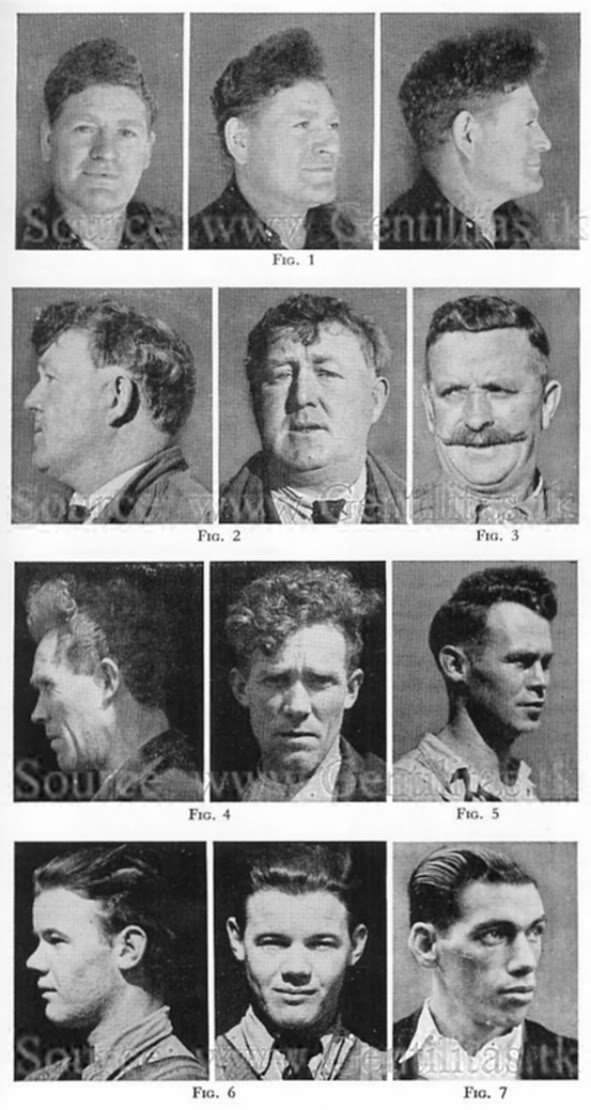
Plate 24. BLUE-EYED ATLANTO-MEDITERRANEANS
As was seen in the case of the Basque on Plate 23, there is a tendency in the tall, extremely long-headed Atlanto-Mediterranean race toward a combination of black dark brown hair and blue eyes. The four men shown on this plate all possess this same pigment combination, all are 170 cm. or over in stature, have head lengths well over 200 mm., and form a unit in regard to general anthropometric and morphological position. All come from regions near the sea, and touched by Megalithic navigators.
FIG.1 (3 views). A Sicilian from Messina. Aberrant in respect to an excessive mandible width, but otherwise typical.
FIG. 2 (3 views). A Spaniard from Vigo, northwestern Spain.
FIG. 3 (3 views). A black-haired Irishman from County Donegal. The Neolithic invaders of Ireland were apparently all or nearly all of this tall, sea-borne Mediterranean variety. This individual is aberrant in head breadth, but otherwise typical.
FIG. 4 (3 views). A Scotsman from Ayrshire. An excellent example of the British Long Barrow type and a direct Neolithic survival.
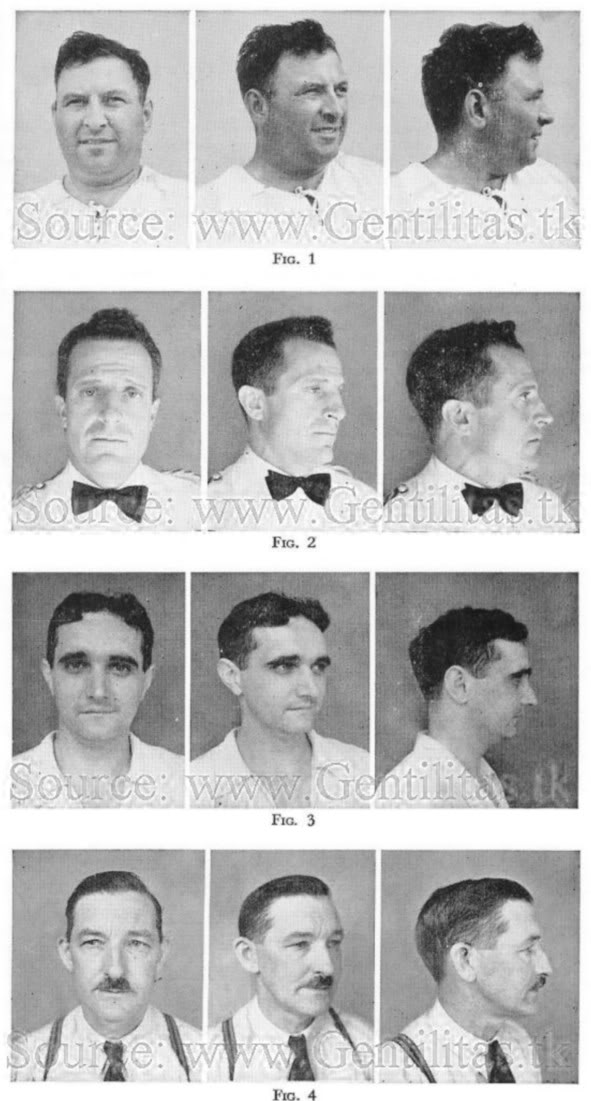
Finish Types
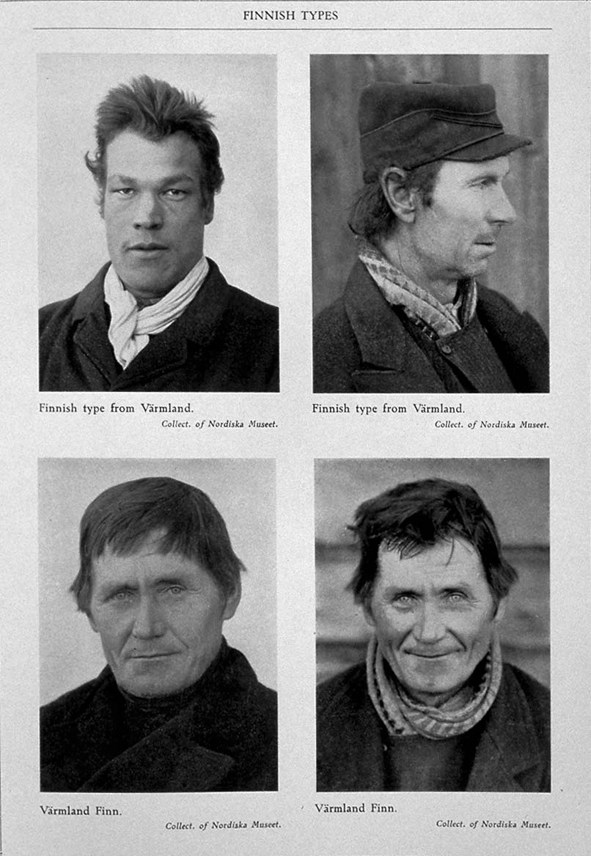
Russian Slavic Women
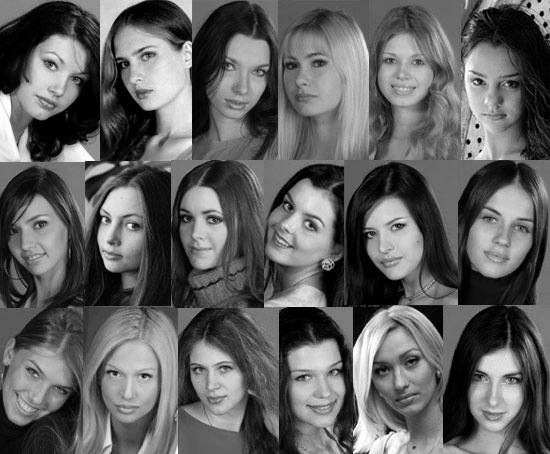
Plate 7. EAST BALTICS
The term East Baltic is properly applicable to a racial type of composite nature, found chiefly in northeastern Germany, Poland, the Baltic States, and Finland, although it also occurs sporadically in Sweden and elsewhere. It is a partially reduced Borreby derivative, with Ladogan and Nordic admixture.
FIG. 1 (2 views, Wide World photos). Field Marshal von Hindenburg, a native of East Prussia, and a classic example of the East Baltic racial type, to which many Prussians of the land-owning Junker class belong.
FIG. 2 (1 view, Pix Publications, Inc.). Field Marshal Werner von Blomberg, a suc- of von Hindenburg, derived from the same ethnic source and a member of the same racial category.
FIG. 3 (3 views). A Pole from Grodno. This individual approaches Borreby dimensions in the cranial vault.
FIG. 4 (3 views). A Lithuanian from the region of Vilna; who shows the Ladogan affiliation of this type clearly.
FIG. 5 (3 views). A Finn from Tampere, Tavastehus. This man seems to show more evidence of Nordic influence than the others. As these pictures show, the East Baltic is not a stable or a basic racial type, but a variable blend.
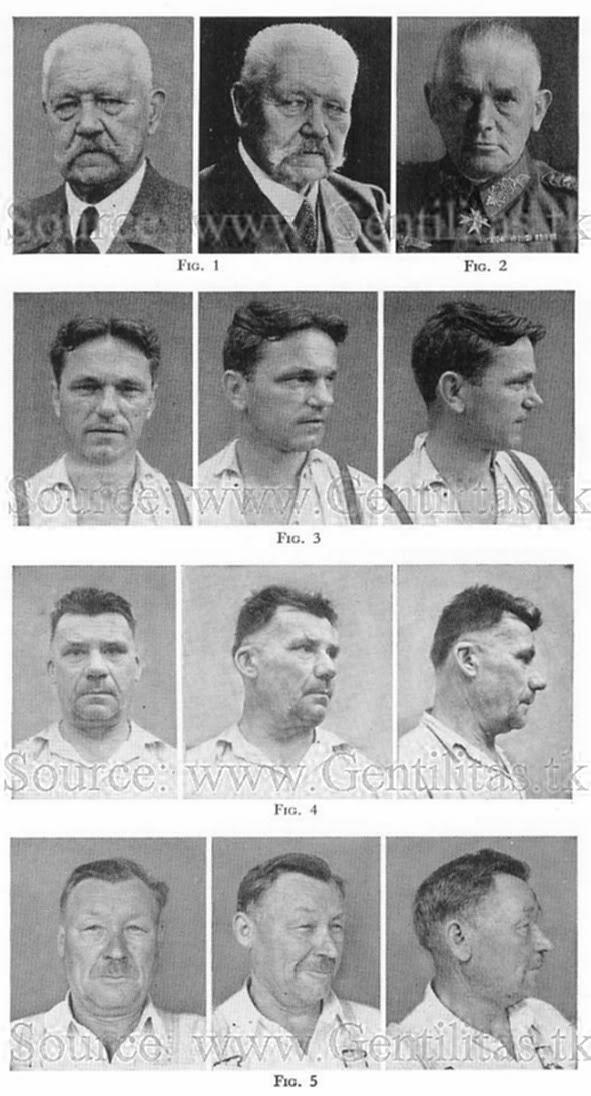
Plate 8. CARPATHIAN AND BALKAN BORREBY-LIKE TYPES
Evidence of the survival of an extremely tall, brachycephalized, Upper Palaeolithic stock is found to a lesser extent in the Carpathians; and to a greater, in the nucleus of the Dinaric Alpine region, from Bosnia to northem Albania, and centered in Montene- gro. Although the presence of these nuclei cannot now be fully explained, it seems probable that they represent local survivals and reemergences of relatively unreduced Upper Palaeolithic populations. The Montenegrins are the tallest people in Europe; their tallness does not, however, imply a thin or linear build; their bodies are frequently thick-set, lateral in constitutional type.
FIG. 1 (3 views). A Carpatho-Russian, or Ruthenian, from the Polish Carpathians. His tall stature, heavy bony structure, large face, etc., point to a basic relationship with the unreduced Upper Palaeolithic survivors of the northwest.
FIG. 2 (3 views). A Montenegrin of aristocratic lineage; in the main an oversized, Upper Palaeolithic survivor, but brunet in pigmentation, like many of the Serbs to whom the Montenegrins are closely related, and who do not, as a rule, possess the over- sized characters of their mountain kinsmen.
FIG.3 (2 views, R. W. Ehrich photo). A blond Montenegrin with extreme width of the cranial vault and mandible.
FIG.4 (1 view); An Albanian from Malsia ë Madhë, near the Montenegrin border.
FIG. 5 (2 views). An Albanian from the clan of Shoshi in the isolated mountain tribe of Dukagin. This man is a blond giant with a broad, heavy-boned body; his face is shorter than the width of his mandible. The unreduced Upper Palaeolithic character of the local mountain type is clearly seen in this individual.
FIG. 6 (1 view). A tall, portly man from Malsia ë Madhë; his facial features show an approach to those of the smaller, less rugged form of the Alpine race, which is particu- larly strong in southem Albania.
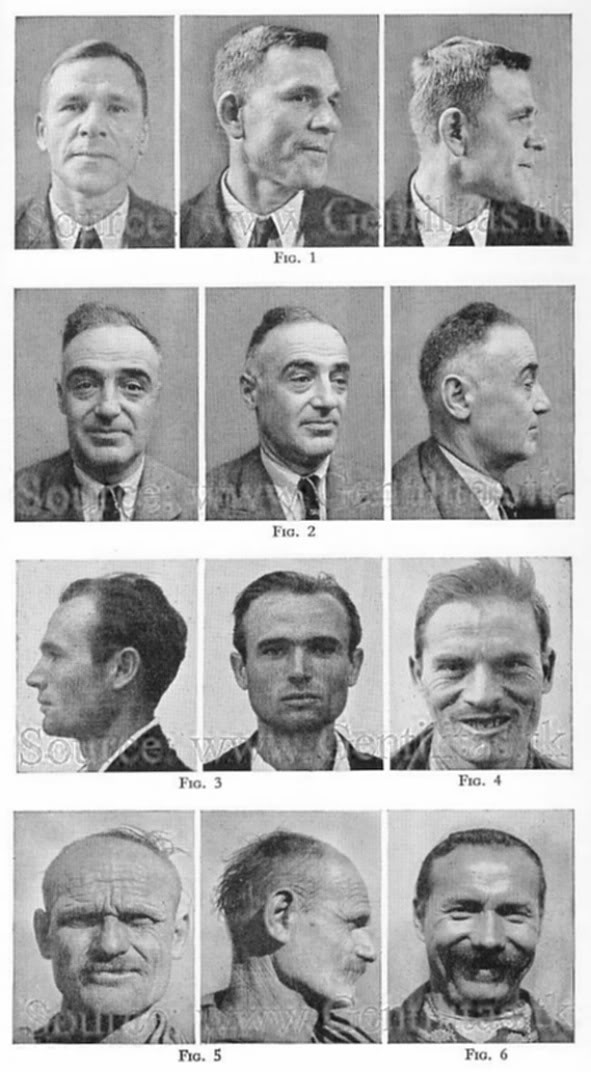
Lapps:
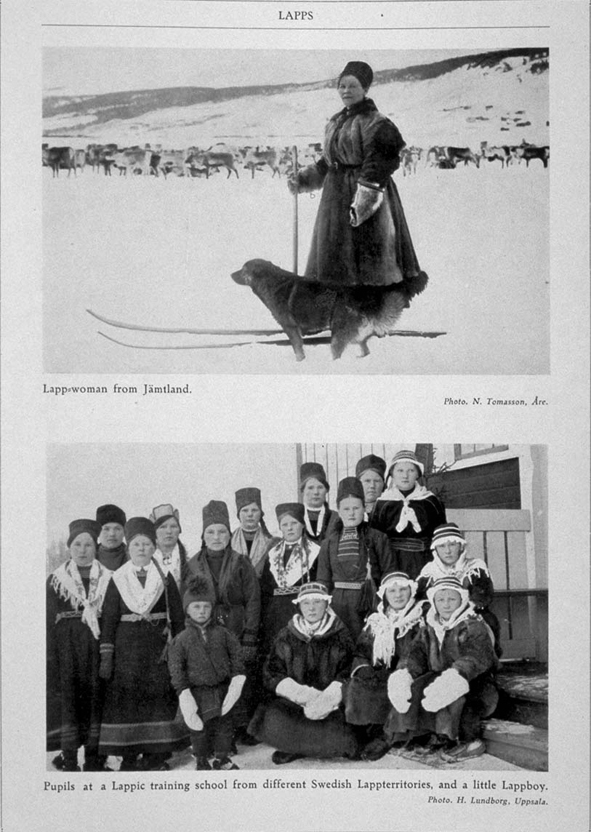
Plate 26. THE PONTIC MEDITERRANEANS
Along the northern and western shores of the Black Sea are found, among other populations, brunet Mediterraneans of a generalized type, called Pontic by the Russian anthropologists, who are usually of medium to tall stature and who seem related on the one hand to the Atlanto-Mediterraneans and on the other to the long-faced Mediter- ranean prototype of Asia Minor and the Caucasus. Inland from the Black Sea shores they are found sporadically in Russia, Poland, and the countries along the upper course of the Danube. They also seem to form an early population level in Serbia and Albania. Their precise archaeological history has not yet been traced, and their relationship to the Danubian invaders of central Europe at the beginning of the local Neolithic is un- known. They do not, however, conform closely to the physical type of the early Danu- bians as known to us by a small series of skeletal remains. Much more work needs to be done in southeastern Europe before their historical position and relationships can be established.
FIG. 1 (3 views). A Bulgarian from Chepelare. An excellent example of the Pontic Mediterranean type, except for an unusually small cranial vault. In Bulgaria this Mediterranean type seems actually in the majority.
FIG. 2 (3 views). Photo F. L Rainer, from Rainer, F; I. Rlcherches Anthropologiques dans Trois Villages Carpathiennes, Bucharest, 1937, Plate II, #3.) A Moldavian farmer This Mediterranean type is common in Rumania on the plains of Moldavia and Wal- lachia, as well as in Bulgaria, but is largely replaced by brachycephalic forms in the Carpathians.
FIG. 3 (3 views). This man, who is an excellent example of the type in question, comes from the region of Vilna, and has a Lithuanian father and a Po!ish mother. He is said to resemble his mother's family. This type is recognized by Polish anthropo!ogists as an element in the population of their country, and is designated by them as Mediter- ranean.
FIG. 4 (3 views). A Czech of Pontic Mediterranean affiliation, unusual in a popula- tion which is for the most part brachycephalic. Bohemia is nearly the last outpost of this type to the west; a few, however, occur in Bavaria.
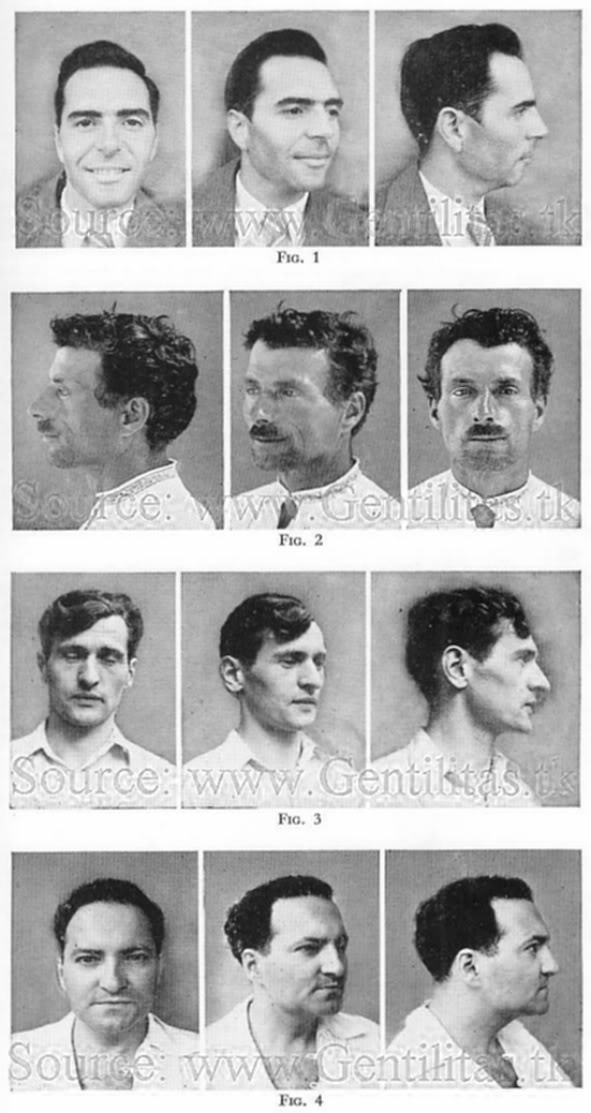
Plate 22. SMALL MEDITERRANEANS OF SOUTHERN EUROPE
The earliest Neolithic invaders of the southern fringe of Europe were brunet Mediterraneans of small to moderate stature and moderate head size. Unaltered representatives of this type or group of types may be found today from Crete to Portugal.
FIG. 1 (3 views). A native of Crete, a perfect representative of the small Mediter- ranean race, similar metrically to the Mediterranean Yemenite Arabs shown on Plate 16, and identical, as nearly as can be determined, with the mean type of Cretans in Minoan times.
FIG.2 (3 views). An equally typical example of the same racial strain, from the region of Naples in Italy. The only aberrant feature of this individual is his blue eyes.
FIG. 3 (3 views). A Mediterranean Spaniard; his father is a Galician, his mother a Cuban of unmixed Spanish descent.
FIG. 4 (3 views). A very dark-skinned, large-headed mesocephalic Mediterranean from Beira Altain Portugal, with heavy beard and body hair. Many of the Portugese belong to this more robust Mediterranean sub-variety, which is also common in southern Italy, and may have been one of the earliest Mediterranean elements to arrive in southwestern Europe.
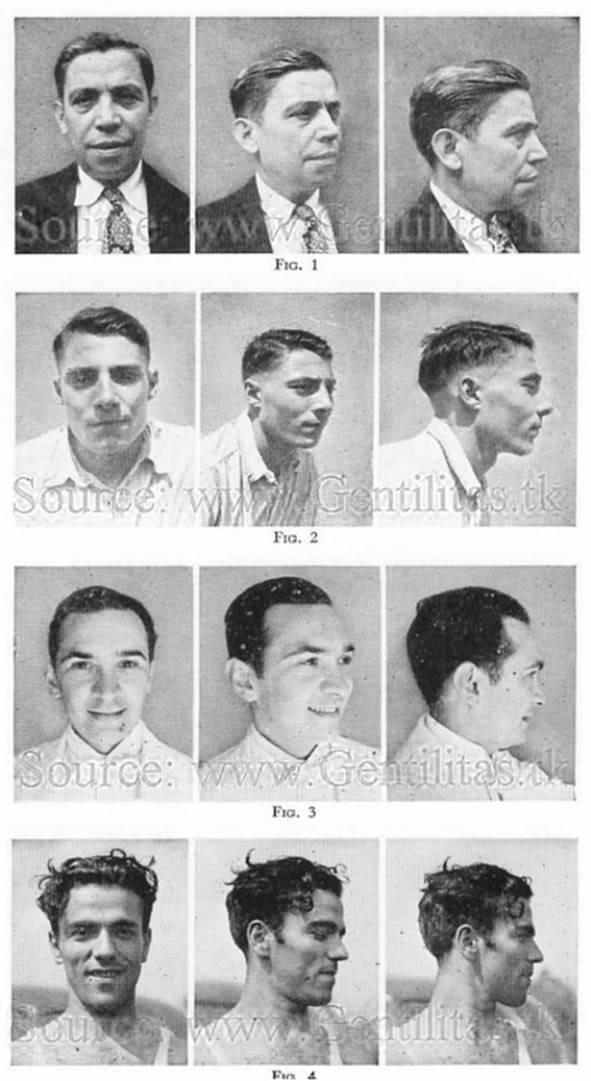
North Asian People: Sub-Races or Ethnicities of North Asia
Han Chinese
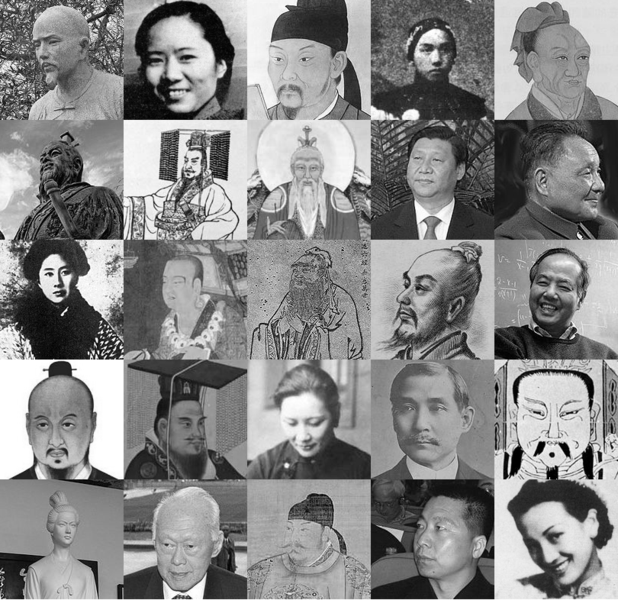

Japanese
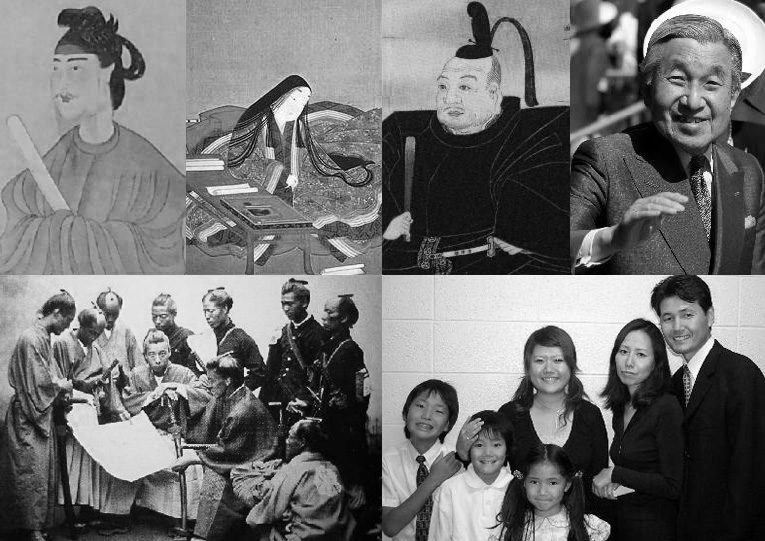
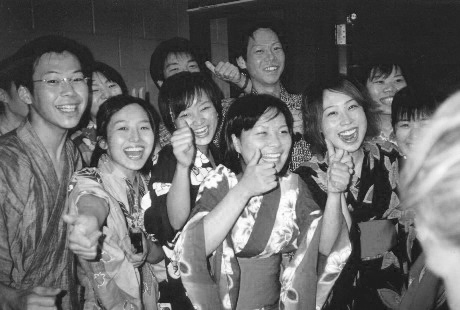
Koreans:

Mongolians

Races, Sub-Races or Ethnicities of the Middle East, North Africa and West Asia
Plate 3. MONGOLOID INFLUENCES IN EASTERN EUROPE AND IN TURKESTAN
The invasions of mongoloid peoples from central Asia during the millennium from about 400 to 1400 A.D. caused the settlement of some Mongols proper (Kalmucks) near the mouth of the Volga, and the partial Mongolizing of some Finnic tribes, especially those which adopted Turkish speech. In Russian Turkestan erstwhile white populations became Mongolized in varying degrees.
FIG. 1 (2 views, photo B. N. Vishnevsky). This deeply brunet Chuvash, a member of a tribe of Turkicized Finns in what is now the Chuvash Republic of eastern Russia, rep- resents, in his facial features, either a pronounced early Ladogan prototype, or Mongol admixture, or both.
FIG. 2 (1 view, photo B.. N. Vishnevsky). A lighter-skinned, less mongoloid Chuvash. The median eyefold and snubbed nasal tip, with laterally oriented nostril axes, are Ladogan rather than mongoloid.
FIG. 3 (3 views, photo J. Wastl, Archiu fur Rassenbilder , Bildaufsatz 2, Archi vkarte 11, 1926. Herausgeber E. von Eickstedt, J. F. Lehmans Verlag, Munchen). A Bashkir member of another tribe of Turkicized Finns living in the Kazan district and the southern Urals. This individual is almost completely mongoloid in the central Asiatic sense.
FIG. 4 (2 views, photo Gordon T. Bowles). An Uzbeg from Russian Turkestan. The Uzbegs are Turkish-speaking inhabitants of the central Asiatic khanates, of mixed origin. This individual shows a partially mongoloid condition usual among these people.
FIG.5 (1 view, photo B. N. Vishnevsky). A Tajik from Russian Turkestan; the Ta- jiks are Iranian-speaking farmers inhabiting the oases of some of the khanates, and the Pamir mountains to the south.. While characteristically European in race, a few of the Tajiks show evidences of mongoloid admixture.
FIG. 6 (3 views, photo B. N. Vishnevsky). An Arabic-speaking native of Russian Turkestan. The remnants of the Arab invasions of the Middle Ages have been mostly absorbed by the Uzbegs, and those who retain their Semitic idiom have been in most cases racially altered. The old man shown here represents a common type in Turkestan regardless of speech or ethnic affiliation; a mixture between a mongoloid and a long- faced local Mediterranean strain, giving a pseudo-Armenoid appearance. Note the long, straight, coarse beard, a common feature among individuals of this type, which von Eickstedt calls Turanid.
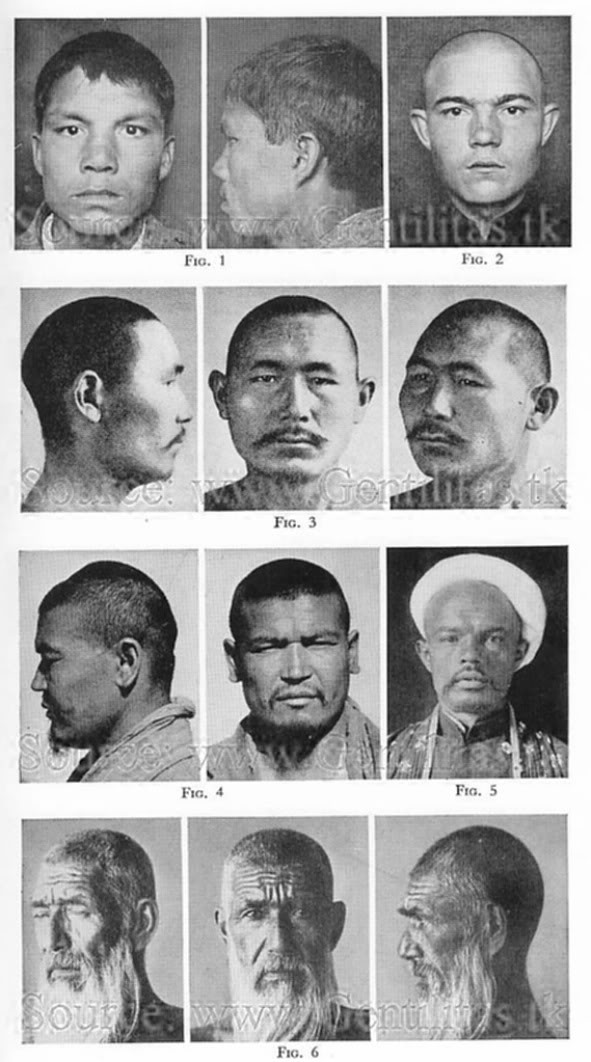
Plate 10. UPPER PALAEOLITHIC SURVIVALS IN MOROCCO
During the Late Pleistocene North Africa was inhabited by the Afalou men, a race of tall, large-headed, heavy-boned, people with exaggeratedly rugged cranial and facial features comparable to those of the Cro-Magnon-Briinn group in Europe. This Afa- lou race bore with it a tendency to brachycephaly. In post-glacial time North Africa has been a highroad of invasion, from the eastern Mediterranean to Europe, and the survivors of those Afalou people who remained are to be found mostly in two refuge areas, the Moroccan Rif and the Canary Islands. Here only the Riffian group will be depicted. In the Rif, besides more numerous Mediterraneans, Nordics, and mixed types, the Afalou strain has survived or reemerged in recognizable form, and may be seen to have gone through an evolution parallel to that of European Upper Palaeolithic survivors in Ireland and on the continent of Europe. As in Europe. these survivors are often blond; as in Ireland. frequently rufous.
FIG. 1 (2 views). A sheikh of Targuist. Blond, metrically comparable to the Nordis, as in the case of the Irishman in
FIG. 4 of the preceding plate, but in the same sense un- Nordic in facial features; probably Nordic mixture is partly responsible.
FIG. 2 (2 views). A larger-headed, mesocephalic example of the same type, compa- rable in features to Northwest Europeans with Borreby blood; like the first example and wholly unlike the Nordic and Mediterranean strains in the Rif, this individual is lateral in constitutional type; heavy boned, and heavily muscled. This man is a fkih (schoo- master and leader of the mosque) in the Riffian tribe of Bern Ulishk.
FIG. 3 (2 views). The kaid or governor of the tribe of Targuist. For some unknown reason Riffians who hold public office usually belong to this physical type. The kaid is rufous, and like many Riffians, could pass for an Irishman if differently clothed and coiffured.
FIG. 4 (2 views). A very blond youth from the Senhajan tribe of Ktama, the most isolated spot in northern Morocco. Facially he resembles a southern Swede; closely similar individuals have been observed in the Canary Islands. The dimensions of his head are small, however; he must be regarded as a mesocephalic, cranially reduced type similar to the Irishman on plate 9,
FIG. 6.
FIG. 5 (2 views). A highland Beni Urriaghel Riffian; short-statured, laterally built, rufous; with a snub nose and short face; a reduced mesocephalic Afalou type.
FIG. 6 (1 view). A kaid of Taghzuth, a small tribe of Senhajan craftsmen located in the high mountain forest immediately west of the Rif. Rufous and exaggeratedly "Irish" in facial features.
FIG.7 (1 view). An old Riffian warrior, one of the Ulad Abd el Mumen clan in the Vale of Iherrushen, Gzennaya. Although indistinguishable metrically from many tall Mediterraneans, this individual possesses morphological features in the region of the eyes, nose, mouth, and jaw, which are clearly of Afalou inspiration, and which give him an "Irish" look.
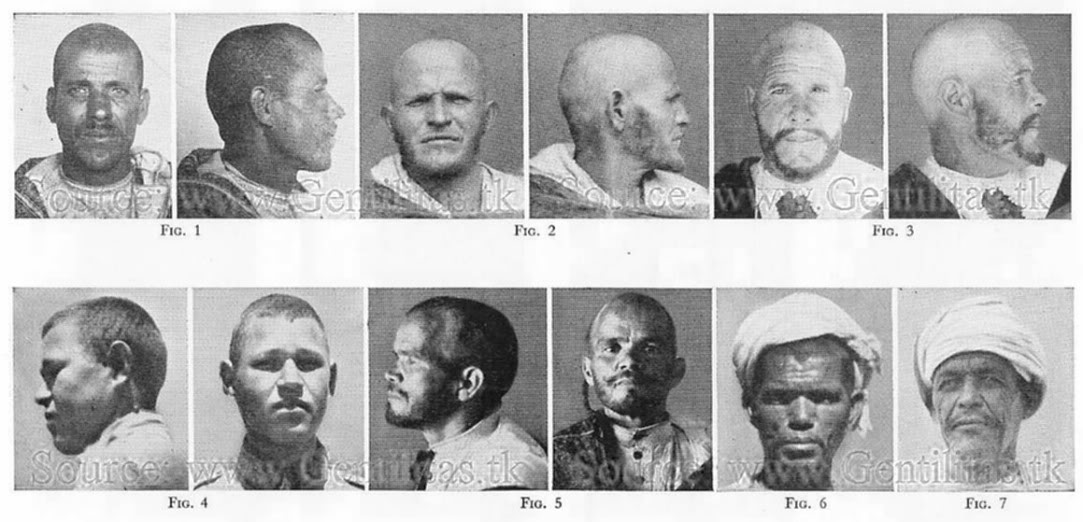
Plate 15. ASIATIC ALPINES
The Alpine race is as important in the mountain zone from Syria to the Pamirs as it is in the corresponding portion of Europe. Both anthropometrically and morphologi- cally, the European and Asiatic Alpines are essentially identical. Furthermore, when not too strongly altered by mixture with other stocks, the Asiatic Alpines tend to an in- termediate pigment condition comparable to that of their European counterparts.
FIG.1 (3 views). A Syrian Alpine from Damascus. This man is typically Alpine, ex- cept perhaps for his rather extreme face length.
FIG. 2 (3 views). A Druze from Shuf, southern Syria. This man is in all respects an excellent Alpine. The Druze, followers of a secret religion based on the schismatic teach- ings of the Khalifa Hakim of the Mediaeval Fatimid Dynasty, claim to be descended from immigrants who moved from Yemen to Syria in the sixth century A.D. Although this tradition may be accurate, nevertheless the majority of the Druzes today are brachycephalic, and show a predominance of Alpine facial characters, which could only have had a local origin.
FIG. 3 (3 views). An Armenian from Cilicia, Asia Minor. The Armenians, for the most part Dinaricized, include in their ranks a minority of individuals who represent, as does this man, the Alpine prototype of the Asia Minor brachycephals.
FIG. 4 (1 view, photo B. N. Vishnevsky). An Iranian speaker from Russian Turke- stan; a good example of a central Asiatic Alpine.
FIG.5 (1 view, photo B. N. Vishnevsky). A Mountain Tajik from the Pamirs. The Tajiks are basically Alpine, and resemble the south-central French closely in an anthro- pometric sense. They form the last major outpost of the Alpine race to the East, as far as we know at present.
FIG. 6 (1 view, from a tempera painting by the artist Iacovleff, from his album Pein- tures d' Asie, Paris, 1935, permission Mme. Iacovleff). An Alpine-looking Hunza from the Hunza valley above Gilgit, in the Himalayas. The western Himalayas, from Kafiri- stan over into Tibet, are proving to be a refuge area of the greatest importance, with interesting racial as well as cultural implications. Nordics, various varieties of Mediter- raneans, as well as Alpines and other strains are apparently preserved in the inaccessible valleys of this territory.
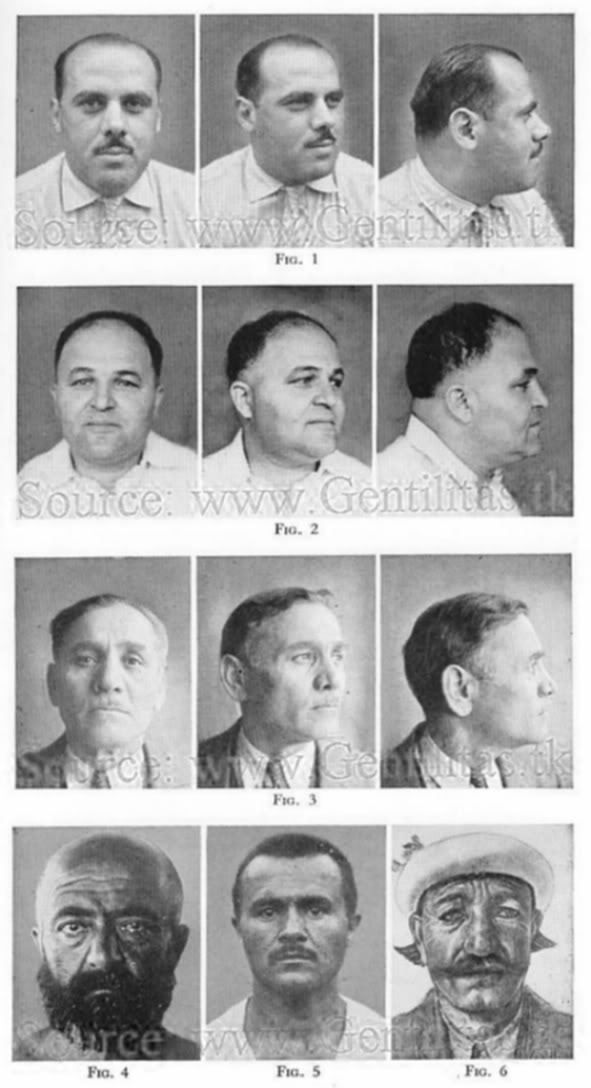
Plate 16. THE MEDITERRANEAN RACE IN ARABIA
The Mediterranean race, in the widest sense, is one of the two basic divisions of the wbite stock. Although varying greatly in stature, different varieties of Mediterraneans do not, as types, attain the bulk, either in head or body size, of the unreduced Upper Palaeolithic group; tall Mediterraneans, whether or not depigmented (partially depig- mented Mediterraneans are Nordics) are usually slender. Small or moderate statured Mediterraneans are as a rule less lateral in build than reduced Upper Palaeolithic sur- vivors. The homeland of the Mediterranean race appears to lie somewhere between East Africa and the Mediterranean, between the Indian Ocean and the Caspian Sea, and between the Egyptian Delta and India. Arabia is centrally located within this general territory, and the parts of Arabia lying west and north of the Ruba' el Khali desert seem to be basic Mediterranean territory.
FIG. 1 (2 views). A youthful Yemeni from the desert-border tribe of Hadha. Facially he is a perfect example of a refined Mediterranean type; his head length is a little short, his stature a little tall, for the mean. He is a brunet-white in unexposed skin color, brunet in hair and eye color; narrower-faced than any of the Upper Palaeolithic sur- vivors, reduced or unreduced, whom we have seen in the preceding plates. His fore- head and jaw are both consistently narrow. It is a characteristic of the Mediterranean race, as of this individual, that the upper face height and nose height are great, no mat- ter how small the other dimensions. Imagine this individual pink-skinned, blue-eyed, and blond-haired, and you will have a close approximation to a Nordic. There is no essential difference between the two races other than pigmentation. Both, however, are separated by a wide racial gap from the Upper Palaeolithic group.
FIG.2 (2 views). Another Yemeni highlander, in this case from the escarpment tribe of Beni Madhar .This man is shorter in stature, and much longer-headed. He is mixed in eye color; some 25 per cent of all pure brunet Mediterranean groups possess a trace of incipient blondism. The cranial and facial dimensions of this individual resemble those of the larger, Atlanto-Mediterranean strain as found in western Europe and North Africa. In Arabia the two are not clearly differentiated.
FIG. 3 (2 views). A Yemeni soldier from the tribe of Khaulan, which goes back his- torically to Sabaean times. Metrically a perfect Mediterranean central type, this indi- vidual possesses a thin, aquiline nose of a type found frequently but by no means ex- clusively among Arabs.
FIG. 4 (2 views, photo Henry Field. Courtesy of the Field Museum of Natural His- tory, Chicago). A Ruwalla Bedawin, a member of an aristocratic tribe of camel breeders who inhabit the Syrian desert. The Ruwalla, more brunet than the Yemenis, resemble them closely in most respects.
FIG. 5 (2 views, photo Henry Field. Courtesy of the Field Museum of Natural His- tory, Chicago). A Solubbi; member of a small group of desert wanderers and outcasts who inhabit the North Arabian desert, travelling in small family groups and serving as hunters and tinkers for the Bedawin. They are the purest Mediterraneans in north- ern Arabia, and probably represent an extremely ancient element in the North Arabian population. This Solubbi may be considered a classical Mediterranean.
FIG. 6 (2 views, photo Henry Field. From Field, Henry, Arabs of Central Iraq, Anth. Mem. of the Field Museum of Natural History, vol. 4, 1935, Plate LXXX). A tall Mediterranean from Iraq. The Iraqians, who are apparently direct and unaltered de- scendants of the ancient Mesopotamians, are Mediterraneans. They are, however, on the whole taller, darker-skinned, longer-faced, and straighter-haired than the Arabs.
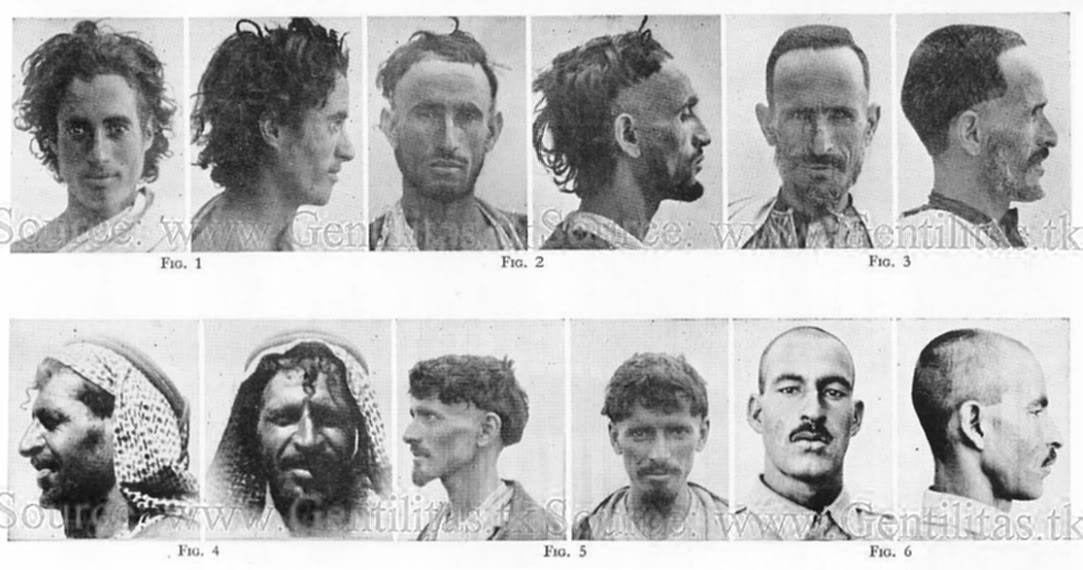
Plate 17. LONG-FACED MEDITERRANEANS OF THE WESTERN ASIATIC HIGHLANDS
In the highland zone of western Asia, aside from the Alpine reemergences already studied, the most important racial type is a moderately tall to tall, slender, brunet Mediterranean type characterized especially by a great length of the face and nose. In Syria and Anatolia, as in Armenia and the Caucasus, this type occurs sporadically in the midst of Alpines and, more commonly, of Alpine-Mediterranean hybrids; in Iran' and Afghanistan the dolichocephalic strain or strains are numerically predominant.
FIG. 1 (3 views). A Turk from Kharput, eastern Turkey. This moderately tall, brunet Mediterranean Turk is remarkable for his considerable head length, and espe- cially for the great height of his upper face and nose. The original Seljuks and Osmanlis who invaded Asia Minor and founded the Turkish Empire probably were men of this same general physical type. Like the Finns, the Turks never were, in all likelihood mongoloid.
FIG. 2 (3 views). A Syrian from Kfar ' Akal, who, although slightly brachycephalized by the prevailing head form of Syria, still retains the essential features of the long-faced, long-nosed Mediterranean prototype of this region.
FIG. 3 (3 views). A dolichocephalic Armenian from Kharput. Dolichocephalic Armenians are rare; this individual appears to be a perfect example of the tall, long- headed, and long-faced Mediterranean prototype which, brachycephalized by Alpine admixture, is at the basis of the Armenian population.
FIG. 4 (2 views, Photo Wm. M. Shanklin). A Cherkess (Circassian) from the north- western Caucasus. The Caucasic peoples include in their racial repertoire a strong bru- net Mediterranean element of the type shown above; this is especially prevalent among the Cherkesses, of whom this individual apparently forms a good example. One can- not be sure, however, in view of his kalpak, that he has not been partly brachycepha- lized.
FIG. 5 (1 view, tempera painting by Iacovleff). This magnificent. head by Iacovleff illustrates an extreme example of the long-faced Mediterranean type characteristic of the Turkomans, who inhabit, besides the plains of Turkestan, some of the mountain districts of northern Iran and Afghanistan.
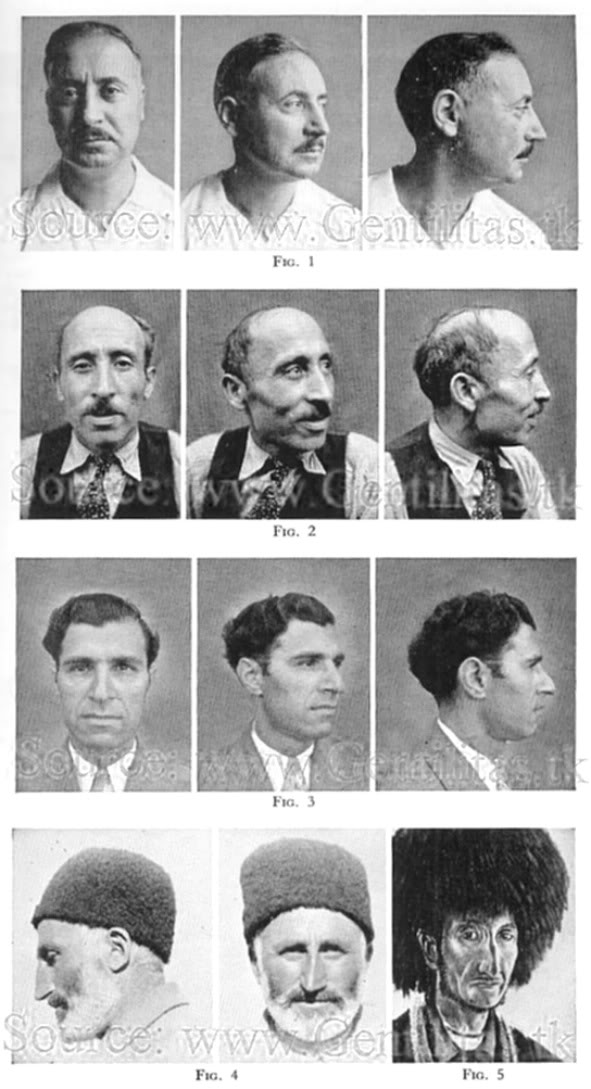
Plate 18. LONG-FACED MEDITERRANEANS OF THE WESTERN ASIATIC HIGHLANDS: THE IRANO-AFGHAN RACE
The individuals shown in the preceding plate might be generally classified within the Irano-Afghan branch of the Mediterranean race, the main diagnostic features of which are an extreme vault length, face height, and nose height. In many instances ex- treme nasal convexity and prominence, and in others an extremely high cranial vault are additional features.
FIG. 1 (2 views, photo Henry Field. Courtesy of the Field Museum of Natural His- tory, Chicago). A Lur from Luristan, Iran.. This Persian tribesman shows in exager- ated degree the great nasal prominence often associated with this branch of the Medi- terranean race, and endemic among many Near Eastern peoples. Not only is the nose convex and salient, but also the forehead is sloping, and the chin receding, although the mandible is deep. FIG: 2 (1 view, tempera painting by Iacovleff). The same racial characters, typical among Kurds, appear in this Baghdadi Kurd in less exaggerated form.
FIG. 3 (1 view, tempera painting by Iacovleff). Although one cannot be sure of the head form of this venerable Persian official from Teheran, his facial features are charac- teristically Irano-Afghan.
FIG. 4 (2 views, photo Gordon T. Bowles). A Mohmand tribesman from eastern Afhanistan. The Afridis and Mohmands of the Khyber Pass country, the traditional harriers of the Northwest Frontier Province, are of the same racial type, for the most part, as the Persians and the Afghanis. This individual might be a brother of the Luri (FIG. 1) from the opposite end of the Irano-Afghan plateau.
FIG. 5 (1 view, tempera painting by Iacovleff). An Afghan, the "son of a nomadic chief." This youth possesses the high, narrow cranial vault common to one variety of the Irano-Afghan race.
FIG. 6 (2 views, photo Wm. M. Shanklin). A tribesman from the desert border of northeastern Syria, this gray-bearded man possesses the high cranial vault mentioned above.
FIG. 7, (2 views, photo Gordon T. Bowles) Closely similar to the Syrian desert border tribesman is this Afridi from eastern Afghanistan. Its high, narrow cranial vault, in combination with a great facial and nasal height, and its general cast of cranial features makes this type nearly identical with that of the Corded people who invaded Europe from the east toward the beginning of the third millennium B.C..
FIG. 8 (1 view, tempera painting by Iacovleff). This Persian from Teheran seems to belong to the same general branch of the Irano-Afghan race as the two preceding. The great length of his nose is an attribute of senility as well as a racial character.
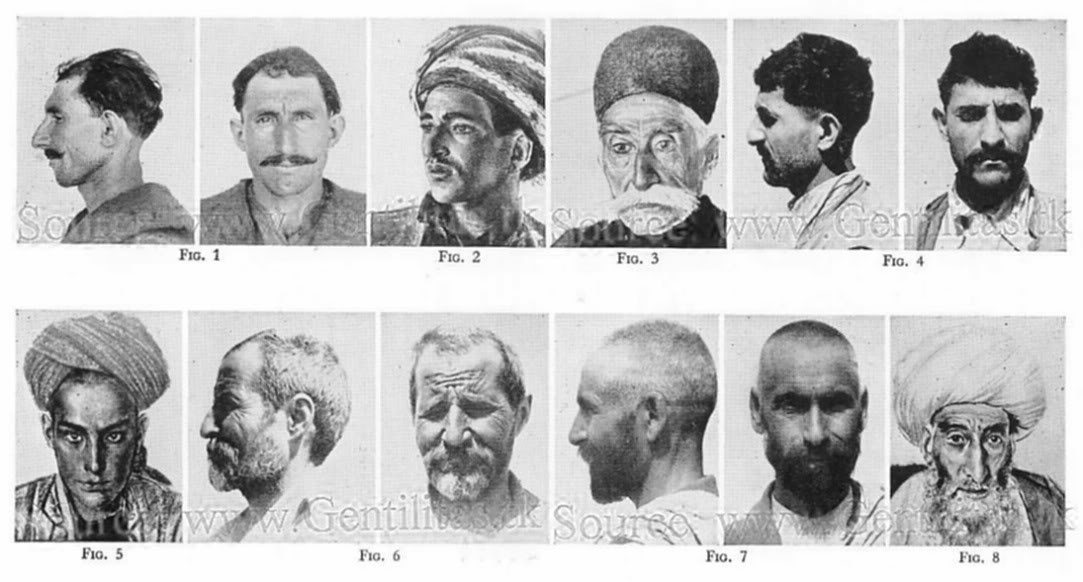
Plate 19. GYPSIES, DARK-SKINNED MEDITERRANEANS, AND SOUTH ARABIAN VEDDOIDS
The Gypsies, who are believed to have left their home in the lower Indus Valley about the turn of the present millennium, and who arrived in Europe some four centuries later, belong, when comparatively unmixed, to a dark-skinned, small-bodied racial type of general Mediterranean appearance which is common in India.
FIG.. 1 (2 views, photo V.. Lebzelter, from "Anthropologische Untersuchungen an serbischen Ziguenern," MAGW, vol. 52, 1922). A nomadic Serbian Gypsy, appar- entJy relatively pure, who shows the characteristic Gypsy combination of straight jet black hair, black eyes, and dark skin; in connection with Mediterranean facial features.
FIG. 2 (2 views).. An English Gypsy of the Cooper family, whose ancestors moved to New England a century ago. Although some of the Coopers and Stanleys are blue- eyed and show other signs of non-Gypsy mixture, this individual possesses a sallow brownish skin, straight, coarse, shiny black hair, and dark brown eyes. He is appar- ently a relatively pure representative of the Gypsy prototype
FIG.3 (2 views). Of much greater antiquity outside of India is a dark-skinned, black- eyed, and straight-haired Mediterranean type which appears with some frequency in southern Iraq and along the coasts of the Persian Gulf. This young sailor from Kuwait will serve as an example. The origin and affiliations of this type have not as yet been fully explained.
FIG. 4 (2 views). In southern Arabia, south of the Ruba' el Khali desert, the popula- tions consist of a Mediterranean upper stratum overlaid upon a non-white racial group whose affinities are with the Vedda of Ceylon, and the curly-haired aboriginal tribes of southern India; more remotely, it possesses strong connections with the aborigines of Australia.. The individual shown in
FIG. 4 is an extreme example of this Veddoid pro- totype. Note the great prognathism, the ringlet hair form, the extreme nasion depres- sion, and the general form of the nose and lips. Except for his light unexposed skin color, this individual, who is quite brown where exposed, could pass for an Australian aborigine.
FIG. 5 (2 views). A coarse type of Hadhramauti, who represents a mixture between the Veddoid element shown above and the Mediterranean race; or who might be called a less extreme example of the former.
FIG. 6 (2 views, photo Wm. M. Shanklin). A coarse, dark-skinned type of Ruwalla Bedawi. Among the North Arabian Bedawin, besides the more delicately formed Medi- terranean types already observed, occur individuals who seem to show relationships with the Veddoid element on the other side of the desert, and perhaps also with the deeply pigmented element of southern Iraq, as exemplified by FIG. 3. Tribes and populations possessing these racial elements do not possess the normal 25 per cent of incipi- ent blondism characteristic of most Mediterranean groups.
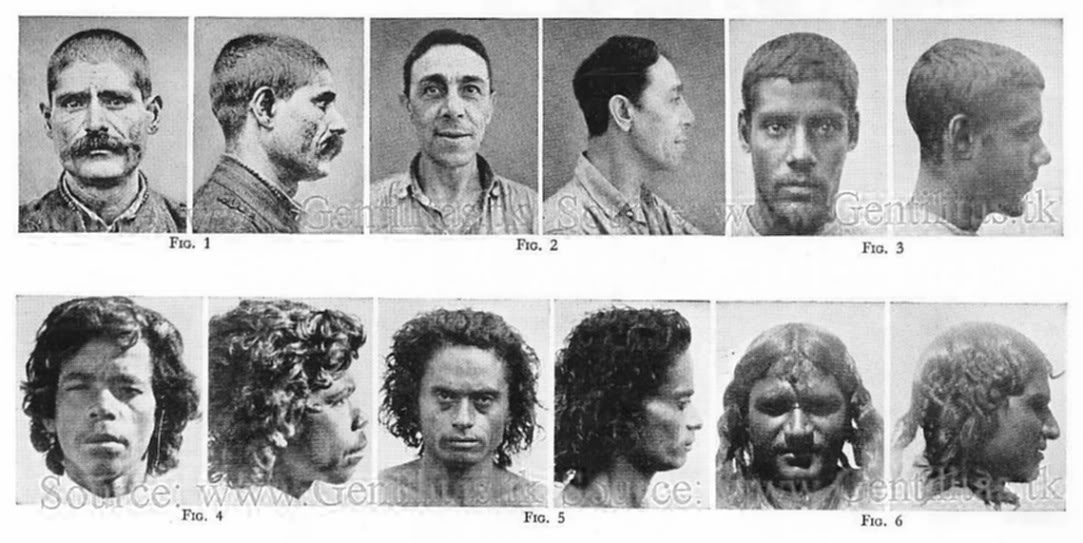
Plate 21. MEDITERRANEANS FROM NORTH AFRICA
FIG. 1 (2 views, photo Ales Hrdlicka. From Hrdlicka, A., Anthropometric Survey of the Natives Of Kharga Oasis, Egypt; MCSI, vol. 59, #1, Washington, D. C., 1912, pl. 14). An oasis dweller from Kharga. This extremely dolichocephalic, low-vaulted, and relatively low-nosed Mediterranean sub-type is typical of the inhabitants of the oases of the Libyan desert, in Siwa and Awjla, where Berber is spoken, as well as in Arabic- speaking Kharga.
FIG. 2 (2 views, photo N. Puccioni, Puccioni, N., Anthropometria delle Genti della Cire- naica, Firenze, 1936, Tab. XVI, #277). A tall, slender North African Arab from the tribe of el Hasa in Cyrenaica. The narrow, prominent nose, the sloping forehead, and the protruding occiput are features typical of the nomadic Arabs of North Africa from Cyrenaica to the Atlantic.
FIG. 3 (2 views, from Zeltner, F. de, " A Propos des Touareg du Sud," RA, vol. 25, 1915, p. 172;
FIG. 3 from original blocks). A young Bourzeinat Tuareg, from the region of Timbuctu; this southern Tuareg shows clearly the Mediterranean character of this Saharan Berber people. Pictures of unveiled Tuareg men are very rare.
FIG. 4 (2 views, photo H. H. Kidder). A moderately tall, long-faced Algerian Kabyle.
FIG. 5 (2 views); A small Mediterranean who may be taken as a type example of this race in its North African form. This individual is a Shluh Berber from the Sous, south- ern Morocco.
FIG. 6 (2 views). An equally standardized Mediterranean from the Riffian coastal tribe of Beni Itteft, northern Morocco. These two individuals may be considered repre- sentatives of the Mediterranean invaders who entered western Europe over Gibraltar in the Neolithic.
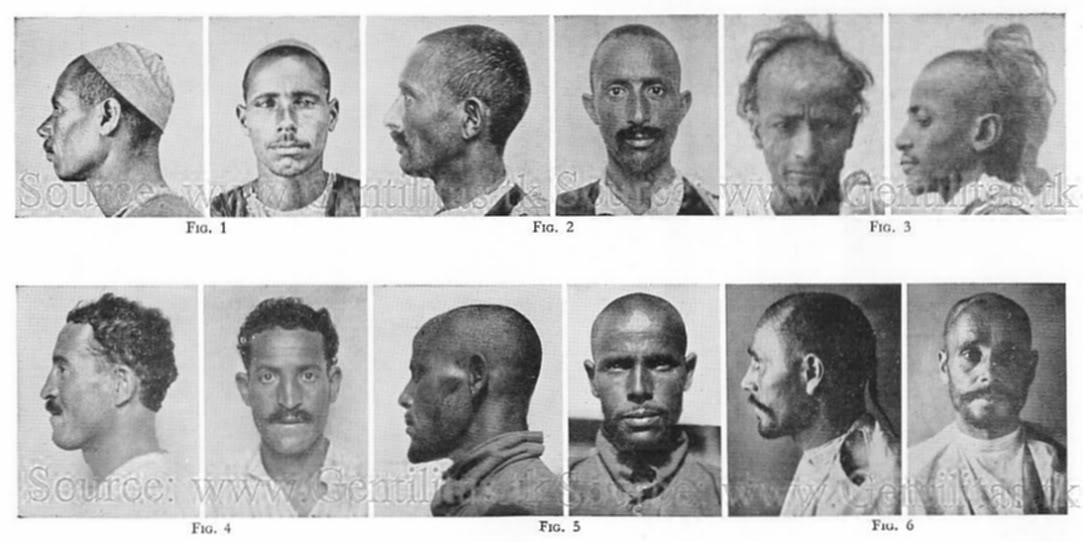
Arab, Mitwali and Alavite, Syria
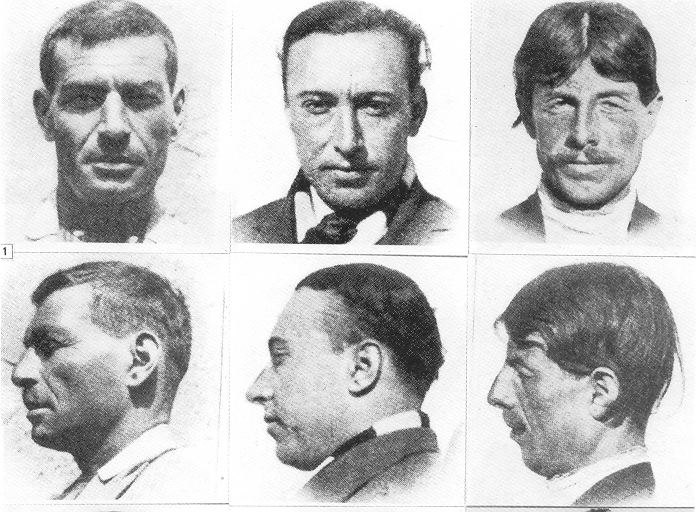
Arab, Kish / Iraq; Samaritan, Nablus / Palestine; Spaniol. Jew, Istanbul
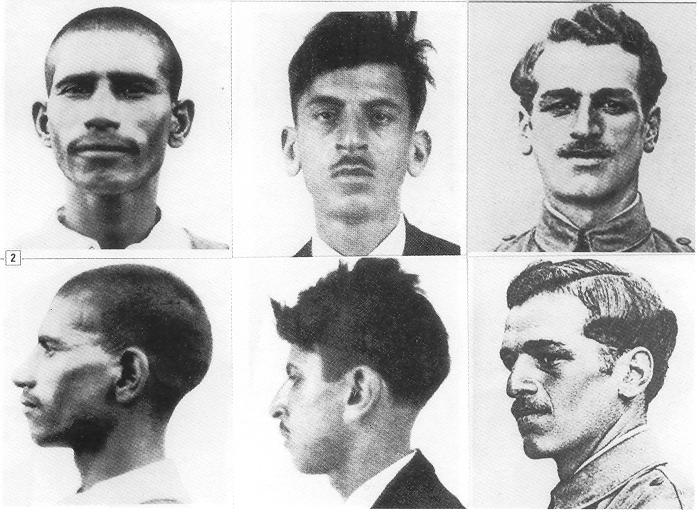
Tajik, N.-Afghanistan; Pashtun, E.-Afghanistan; Baluch, S.-Afghanistan
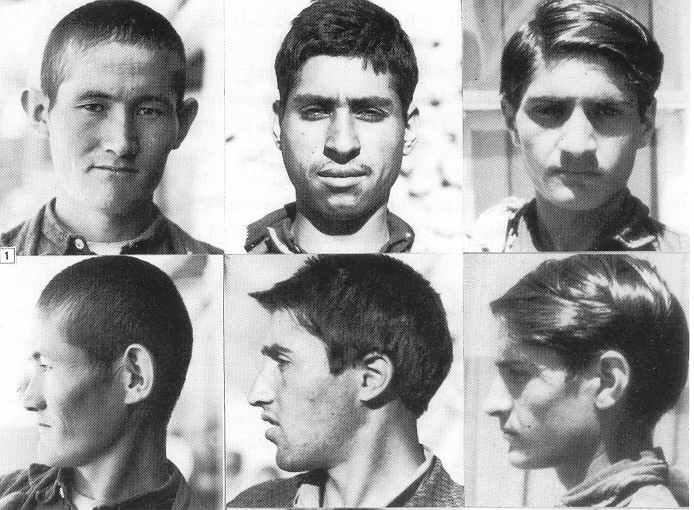
Turk, village near Ankara, Turkey; Azeri, Azerbaijan; Qashgais, SW.-Iran
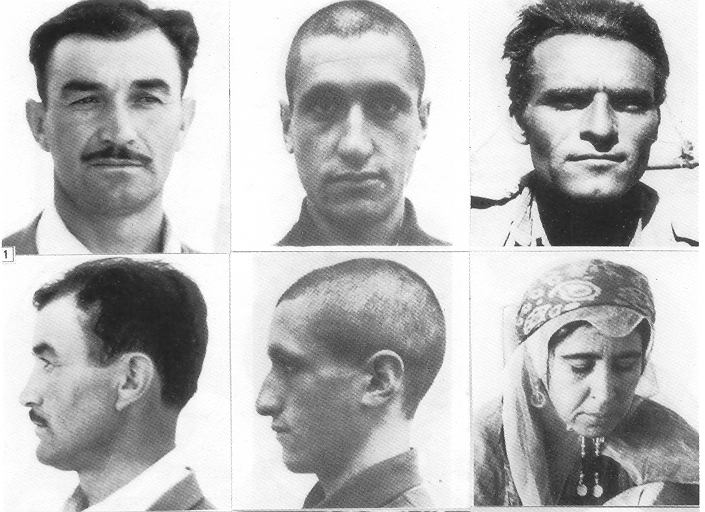
Uzbek and Tajik-Uzbek, N.-Afghanistan; Turkmens, NW.-Afghanistan; Moghol and Hazara, central Afghanistan
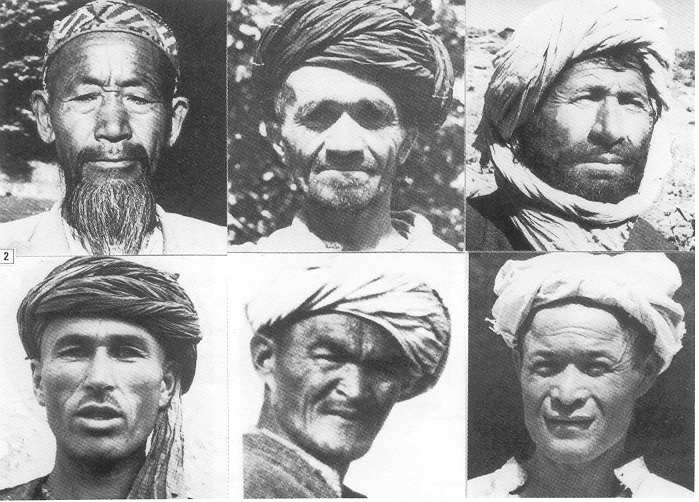
Races, Sub-Races or Ethnicities of South Asia / India
Modern genetics suggests that Indians are an admixture of Australoid, Austro-Asiatic, Mongoloid, Negrito, Dravidian, Ancestral North Indian (ANI), Caucasoid, etc.
Dravidians
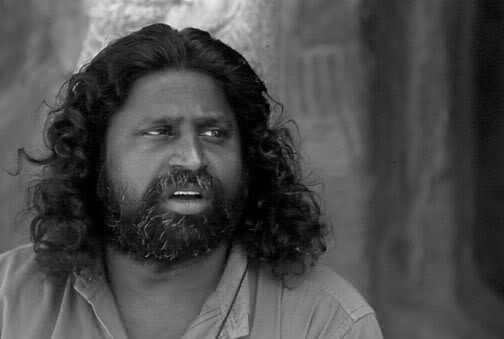
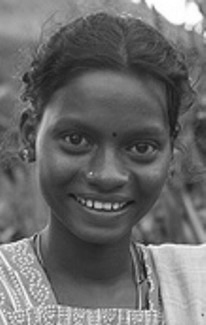
Kanikar
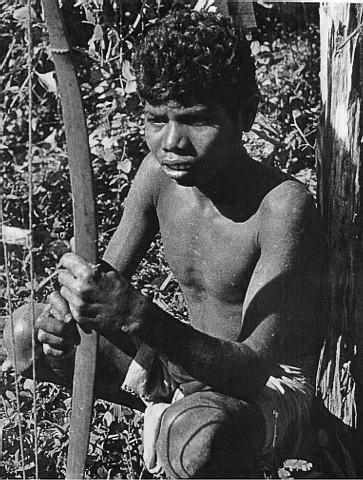
North Indian
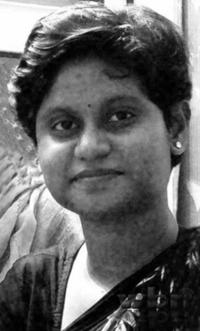
Northwest India Brahmin
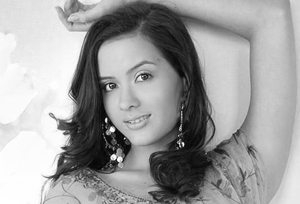
Northeast India Naga
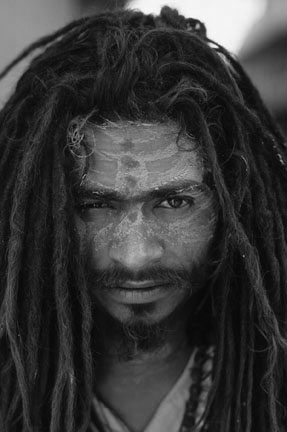
Black People: Sub-Races or Ethnicities of Africa
!Kung Bushmen
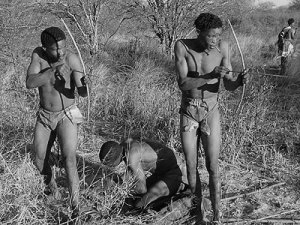
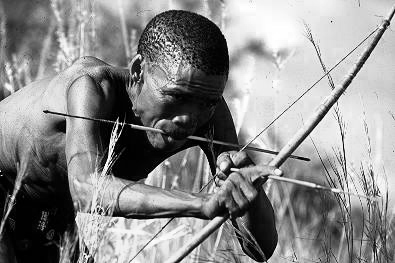
Hadza
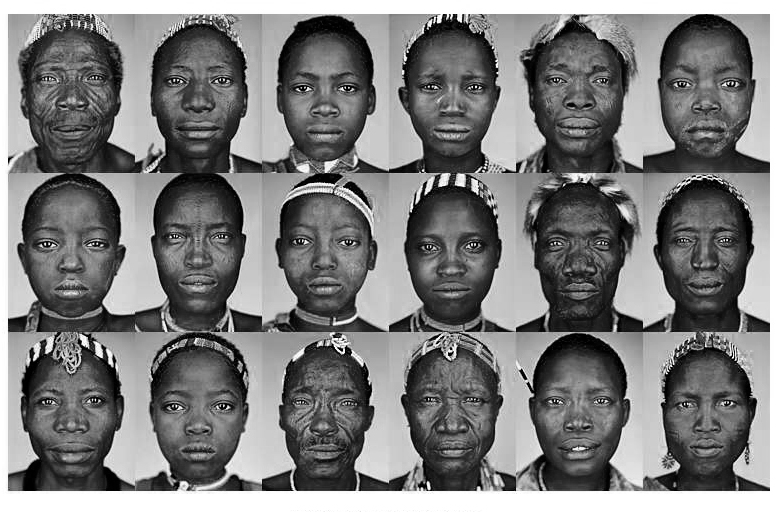
Khoisan
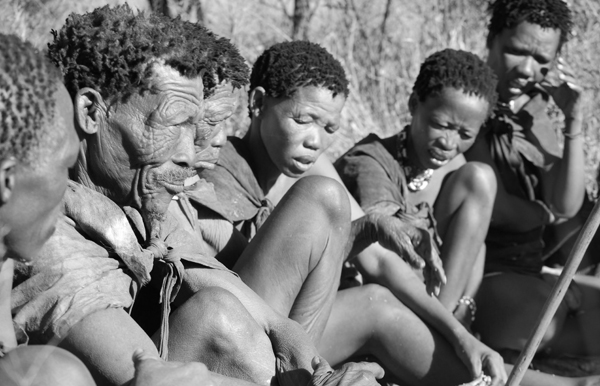
Pygmies
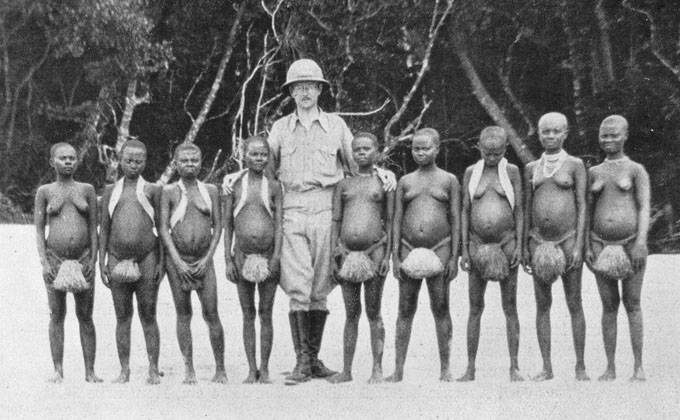
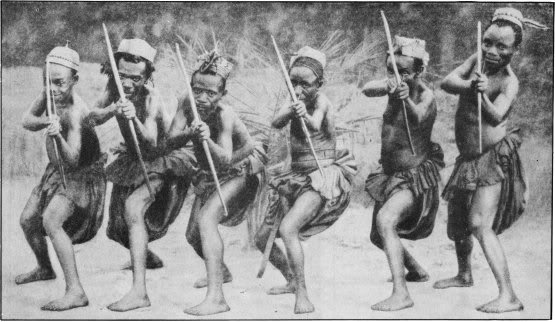
Bantu
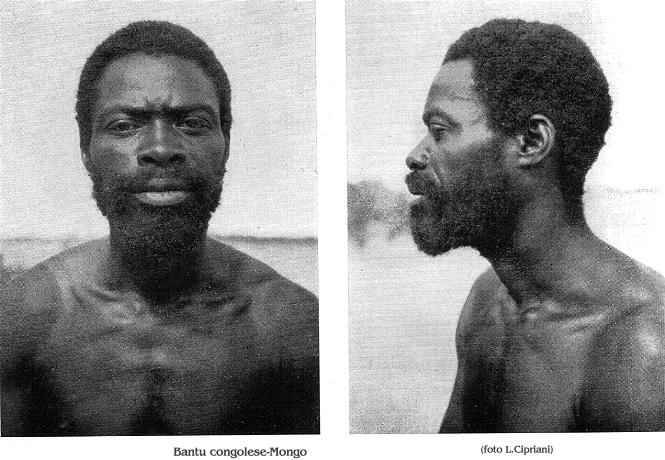
Plate 20. THE NEGROID PERIPHERY OF THE MEDITERRANEAN RACE
Negroes with small amounts of Mediterranean blood. In the deserts and highlands of Ethiopia, Eritrea, and the Somalilands is found a con- centration of several related Mediterranean types, mixed in varying degrees with negroes. To the west these partial whites border on Sudanese negroes; to the southwest the partially Hamitic tribes of Kenya and Uganda form art extension of the peripheral Mediterranean racial area. To the north, the Beja-Bisharin group of Hamitic-speaking nomads connect the East African Hamitic-speaking peoples with their wholly white Egyptian and Berber relatives of North Africa.
FIG. 1 (2 views). A Somali from the tribe of Mahmud Grade, British Somaliland. This Somali represents the closest approximation to a white man found among his people. The extreme narrowness of his head and face, the straight nasal profile, and the prominence of his chin, mark him as less negroid than many of his fellows. At the same time his skin is nearly black, his hair curly but not frizzly. The type to which this So- mali belongs is ancient in East Africa, as shown by the excavations of Leakey in Kenya. It is a specialized, locally differentiated Mediterranean racial form.
FIG. 2 (2 views). Closer to the standard Mediterranean type of Arabia and North Africa is this senile Agau, a member of a fast diminishing group of Hamitic-speaking aborigines in the kingdom of Gojjam in northern Ethiopia. Although his skin is dark, his hair is nearly straight, and his measurements as well as his cranial and facial fea- tures are purely or almost purely Mediterranean. He shows no visible signs of negroid admixture, although from a purely genetic standpoint some must be present.
FIG. 3 (2 views). This individual is a tall, slender Semitic-speaking Ethiopian from the kingdom of Shoa. Except for his hair form he is essentially white and Mediter- ranean. His skin is a sallow yellowish, of a hue often seen among attenuated negro- white hybrids in America.
FIG.4 (2 views). A Hamitic-speaking Wollega Galla, frizzly haired but otherwise not specifically negroid. There is a non-negroid brachycephalic strain in Ethiopia, with heavy browridges and a strong facial bony structure. This individual shows some traits characteristic of this element.
FIG. 5 (1 view, © Karakashian Bros. Tropical Photo Stores, Khartoum). The Mediterranean quality found among the partly negroid Beja and Bisharin is most evi- dent in the female sex. Their bodily build and breast form; as well as their facial fea- tures and hair form, show this especially. This Baggara woman from the Anglo-Egyptian Sudan is less negroid than the majority.
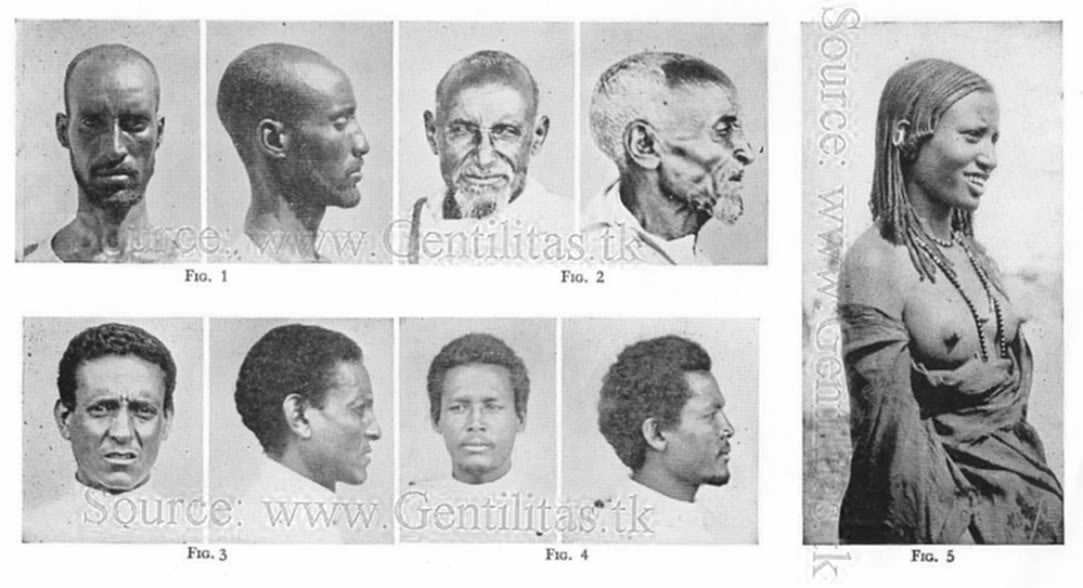
African Americans
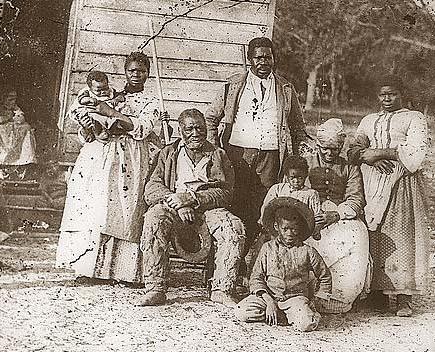
Non-European Races, Sub-Races or Ethnicities of Latin America
Read: "What Race Are Hispanics?"
Belizean Mestizos
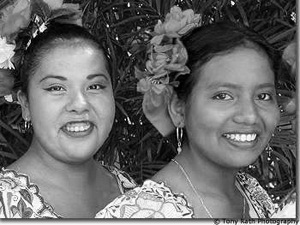
Brazilian Amerindians
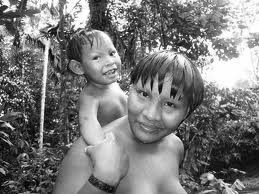
Brazilian Mestizos
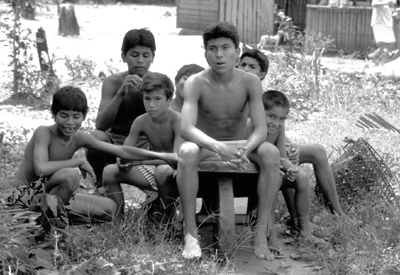
Brazilian Mulatto
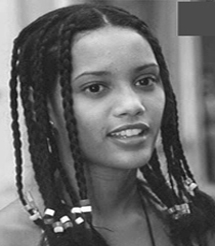
Mexican Mestizos
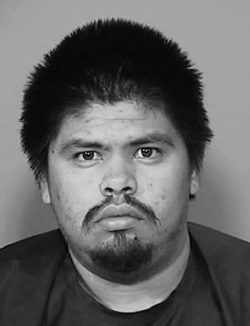

Mexican Amerindians
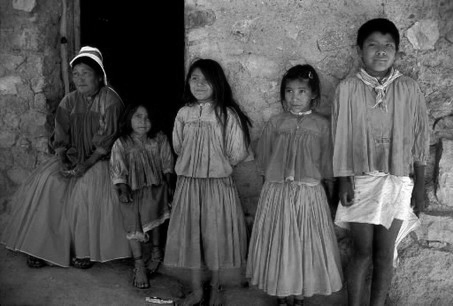
------
Donate:
This is a work in progress. Please send corrections, suggestions and faceplates (esp. of North Asians) to: hbdbibliography AT gmail.com